1.Установка prometheus
2.exporter nginx(ingress-controller)
3.exporter elasticsearch
4.exporter rabbitmq
5.exporter redis
6.настройка оповещений в telegram
6.1 настройка оповещений в telegram в различные чаты(группы)
6.2. настройка оповещений в telegram разграничение оповещений по группам (исключения уведомлений)
7.Проблема с prometheus-kube-proxy
8.Настройка алерта для определённого неймспейса
9.Добавление оповещений и по email
10. Настройка графиков в grafana
git clone https://github.com/prometheus-community/helm-charts.git
cd helm-charts/charts/kube-prometheus-stack/
докачиваем чарты:
helm dep update
создаём namescpase в котором будет всё крутиться:
kubectl create ns monitoring
теперь рассмотрим что правим в переменных у helm chart:
[root@prod-vsrv-kubemaster1 charts]# vim kube-prometheus-stack/values.yaml
namespaceOverride: «monitoring»
для работы telegram бота:
## Alertmanager configuration directives
## ref: https://prometheus.io/docs/alerting/configuration/#configuration-file
## https://prometheus.io/webtools/alerting/routing-tree-editor/
##
config:
global:
resolve_timeout: 5m
route:
receiver: 'telegram'
routes:
- match:
severity: critical
repeat_interval: 48h
continue: true
receiver: 'telegram'
- match:
alertname: Watchdog
repeat_interval: 48h
continue: true
receiver: 'telegram'
receivers:
- name: 'telegram'
webhook_configs:
- send_resolved: true
url: 'http://alertmanager-bot:8080'
templates:
- '/etc/alertmanager/config/*.tmpl'
настраиваем ingress у alertmanager:
ingress:
enabled: true
hosts:
- alertmanager.prod.test.local
paths:
- /
настраиваем volume для Alertmanager отмечу что в кластере настроен nfs-provisioner — nfs-storageclass
ingress:
enabled: true
hosts:
- alertmanager.prod.test.local
paths:
- /
теперь настроим grafana
тут указываем ingress а также добавляем хранение dashboard в nfs storage-class
grafana:
enabled: true
namespaceOverride: "monitoring"
## Deploy default dashboards.
##
defaultDashboardsEnabled: true
adminPassword: prom-operator
ingress:
## If true, Grafana Ingress will be created
##
enabled: true
labels: {}
## Hostnames.
## Must be provided if Ingress is enable.
##
hosts:
- grafana.prod.test.local
#hosts: []
## Path for grafana ingress
path: /
## TLS configuration for grafana Ingress
## Secret must be manually created in the namespace
##
tls: []
# - secretName: grafana-general-tls
# hosts:
# - grafana.example.com
persistence:
type: pvc
enabled: true
storageClassName: nfs-storageclass
accessModes:
- ReadWriteMany
size: 5Gi
# annotations: {}
finalizers:
- kubernetes.io/pvc-protection
## If using kubeControllerManager.endpoints only the port and targetPort are used
##
service:
port: 10252
targetPort: 10252
selector:
k8s-app: kube-controller-manager
# component: kube-controller-manager
## If using kubeScheduler.endpoints only the port and targetPort are used
##
service:
port: 10251
targetPort: 10251
selector:
k8s-app: kube-scheduler
# component: kube-scheduler
## Configuration for kube-state-metrics subchart
##
kube-state-metrics:
namespaceOverride: "monitoring"
rbac:
create: true
podSecurityPolicy:
enabled: true
## Configuration for prometheus-node-exporter subchart
##
prometheus-node-exporter:
namespaceOverride: "monitoring"
теперь настраиваем ingress для prometheus
ingress:
enabled: true
annotations: {}
labels: {}
## Hostnames.
## Must be provided if Ingress is enabled.
##
hosts:
- prometheus.prod.test.local
## Paths to use for ingress rules -
##
paths:
- /
а так же volume:
## Prometheus StorageSpec for persistent data
## ref: https://github.com/prometheus-operator/prometheus-operator/blob/master/Documentation/user-guides/storage.md
##
storageSpec:
volumeClaimTemplate:
spec:
storageClassName: nfs-storageclass
accessModes: ["ReadWriteMany"]
resources:
requests:
storage: 10Gi
и теперь важная фишка, добавление label который надо будет добавить на все неймспейсы:
## Namespaces to be selected for ServiceMonitor discovery.
##
serviceMonitorNamespaceSelector:
matchLabels:
prometheus: enabled
## Log level for Alertmanager to be configured with.
##
logLevel: info
## Size is the expected size of the alertmanager cluster. The controller will eventually make the size of the
## running cluster equal to the expected size.
replicas: 3
также правим:
## Enable scraping /metrics/resource from kubelet's service
## This is disabled by default because container metrics are already exposed by cAdvisor
##
resource: true
для выставления срока хранения данных можем поменять следующее значение:
## Time duration Alertmanager shall retain data for. Default is '120h', and must match the regular expression
## [0-9]+(ms|s|m|h) (milliseconds seconds minutes hours).
##
retention: 120h
запускаем теперь helm chart
[root@prod-vsrv-kubemaster1 charts]# helm upgrade —install -name prometheus kube-prometheus-stack/ -f kube-prometheus-stack/values.yaml —namespace monitoring
Release "prometheus" does not exist. Installing it now.
NAME: prometheus
LAST DEPLOYED: Thu Mar 4 13:25:07 2021
NAMESPACE: monitoring
STATUS: deployed
REVISION: 1
NOTES:
kube-prometheus-stack has been installed. Check its status by running:
kubectl --namespace monitoring get pods -l "release=prometheus"
Visit https://github.com/prometheus-operator/kube-prometheus for instructions on how to create & configure Alertmanager and Prometheus instances using the Operator.
видим что при запуске добавился label release=prometheus — проверяем:
kubectl describe pod prometheus-kube-prometheus-operator-659d5f8674-qxrf5 -n monitoring | grep -i release
release=prometheus
смотрим label на всех неймсмейсах:
kubectl get ns —show-labels
NAME STATUS AGE LABELS
default Active 192d <none>
elk Active 63d <none>
ingress-nginx Active 192d name=ingress-nginx
keda Active 86d <none>
kube-node-lease Active 192d <none>
kube-public Active 192d <none>
kube-system Active 192d name=kube-system
m-logstash-megabuilder Active 12d <none>
monitoring Active 3h15m <none>
terminal-soft Active 176d <none>
проставим на них label release=prometheus
kubectl label namespace —all «prometheus=enabled»
проверяем:
kubectl get ns —show-labels
NAME STATUS AGE LABELS
default Active 192d prometheus=enabled
elk Active 63d prometheus=enabled
ingress-nginx Active 192d name=ingress-nginx,prometheus=enabled
keda Active 86d prometheus=enabled
kube-node-lease Active 192d prometheus=enabled
kube-public Active 192d prometheus=enabled
kube-system Active 192d name=kube-system,prometheus=enabled
m-logstash-megabuilder Active 12d prometheus=enabled
monitoring Active 3h16m prometheus=enabled
terminal-soft Active 176d prometheus=enabled
теперь настроим сбор метрик с ingress controller,
создаём сервис для ingress. Указываем namespace в котором работает ingress, так же необходим label app.kubernetes.io/name: ingress-nginx данный лейб смотрим так:
kubectl describe pod -n ingress-nginx ingress-nginx-controller-vqjkl | grep -A3 Labels
Labels: app.kubernetes.io/name=ingress-nginx
app.kubernetes.io/part-of=ingress-nginx
controller-revision-hash=bd6d56f49
pod-template-generation=1
mkdir exporter-ingres
cat exporter-ingres/service.yaml
apiVersion: v1
kind: Service
metadata:
labels:
app.kubernetes.io/name: ingress-nginx
release: prometheus
name: ingress-nginx
namespace: ingress-nginx
spec:
ports:
- name: http
port: 80
protocol: TCP
targetPort: 80
- name: https
port: 443
protocol: TCP
targetPort: 443
- name: prometheus
port: 10254
protocol: TCP
targetPort: 10254
selector:
app.kubernetes.io/name: ingress-nginx
В данном файле так же обращаем внимание на:
name: prometheus
на это имя будет натравлен port у ServiceMonitor
теперь создаём ServiceMonitor, он будет создавать в prometheus target с метриками ingress controller:
cat exporter-ingres/service-monitor.yaml
apiVersion: monitoring.coreos.com/v1
kind: ServiceMonitor
metadata:
labels:
app: ingress-nginx
release: prometheus
name: ingress-nginx
namespace: monitoring
spec:
endpoints:
- honorLabels: true
interval: 10s
path: /metrics
port: prometheus
scheme: http
scrapeTimeout: 10s
namespaceSelector:
any: true
selector:
matchLabels:
app.kubernetes.io/name: ingress-nginx
release: prometheus
также правим:
## Enable scraping /metrics/resource from kubelet's service
## This is disabled by default because container metrics are already exposed by cAdvisor
##
resource: true
применяем:
[root@prod-vsrv-kubemaster1 charts]# kubectl apply -f exporter-ingres/service.yaml -f exporter-ingres/service-monitor.yaml
через пару минуток проверяем в prometheus

общий вид у файла values.yaml будет следующий:
cat helm-charts/charts/kube-prometheus-stack/values.yaml
# Default values for kube-prometheus-stack.
# This is a YAML-formatted file.
# Declare variables to be passed into your templates.
## Provide a name in place of kube-prometheus-stack for `app:` labels
##
nameOverride: ""
## Override the deployment namespace
##
namespaceOverride: "monitoring"
## Provide a k8s version to auto dashboard import script example: kubeTargetVersionOverride: 1.16.6
##
kubeTargetVersionOverride: ""
## Provide a name to substitute for the full names of resources
##
fullnameOverride: ""
## Labels to apply to all resources
##
commonLabels: {}
# scmhash: abc123
# myLabel: aakkmd
## Create default rules for monitoring the cluster
##
defaultRules:
create: true
rules:
alertmanager: true
etcd: true
general: true
k8s: true
kubeApiserver: true
kubeApiserverAvailability: true
kubeApiserverError: true
kubeApiserverSlos: true
kubelet: true
kubePrometheusGeneral: true
kubePrometheusNodeAlerting: true
kubePrometheusNodeRecording: true
kubernetesAbsent: true
kubernetesApps: true
kubernetesResources: true
kubernetesStorage: true
kubernetesSystem: true
kubeScheduler: true
kubeStateMetrics: true
network: true
node: true
prometheus: true
prometheusOperator: true
time: true
## Runbook url prefix for default rules
runbookUrl: https://github.com/kubernetes-monitoring/kubernetes-mixin/tree/master/runbook.md#
## Reduce app namespace alert scope
appNamespacesTarget: ".*"
## Labels for default rules
labels: {}
## Annotations for default rules
annotations: {}
## Additional labels for PrometheusRule alerts
additionalRuleLabels: {}
## Deprecated way to provide custom recording or alerting rules to be deployed into the cluster.
##
# additionalPrometheusRules: []
# - name: my-rule-file
# groups:
# - name: my_group
# rules:
# - record: my_record
# expr: 100 * my_record
## Provide custom recording or alerting rules to be deployed into the cluster.
##
additionalPrometheusRulesMap: {}
# rule-name:
# groups:
# - name: my_group
# rules:
# - record: my_record
# expr: 100 * my_record
##
global:
rbac:
create: true
pspEnabled: true
pspAnnotations: {}
## Specify pod annotations
## Ref: https://kubernetes.io/docs/concepts/policy/pod-security-policy/#apparmor
## Ref: https://kubernetes.io/docs/concepts/policy/pod-security-policy/#seccomp
## Ref: https://kubernetes.io/docs/concepts/policy/pod-security-policy/#sysctl
##
# seccomp.security.alpha.kubernetes.io/allowedProfileNames: '*'
# seccomp.security.alpha.kubernetes.io/defaultProfileName: 'docker/default'
# apparmor.security.beta.kubernetes.io/defaultProfileName: 'runtime/default'
## Reference to one or more secrets to be used when pulling images
## ref: https://kubernetes.io/docs/tasks/configure-pod-container/pull-image-private-registry/
##
imagePullSecrets: []
# - name: "image-pull-secret"
## Configuration for alertmanager
## ref: https://prometheus.io/docs/alerting/alertmanager/
##
alertmanager:
## Deploy alertmanager
##
enabled: true
## Api that prometheus will use to communicate with alertmanager. Possible values are v1, v2
##
apiVersion: v2
## Service account for Alertmanager to use.
## ref: https://kubernetes.io/docs/tasks/configure-pod-container/configure-service-account/
##
serviceAccount:
create: true
name: ""
annotations: {}
## Configure pod disruption budgets for Alertmanager
## ref: https://kubernetes.io/docs/tasks/run-application/configure-pdb/#specifying-a-poddisruptionbudget
## This configuration is immutable once created and will require the PDB to be deleted to be changed
## https://github.com/kubernetes/kubernetes/issues/45398
##
podDisruptionBudget:
enabled: false
minAvailable: 1
maxUnavailable: ""
## Alertmanager configuration directives
## ref: https://prometheus.io/docs/alerting/configuration/#configuration-file
## https://prometheus.io/webtools/alerting/routing-tree-editor/
##
config:
global:
resolve_timeout: 5m
route:
receiver: 'telegram'
routes:
- match:
severity: critical
repeat_interval: 48h
continue: true
receiver: 'telegram'
- match:
alertname: Watchdog
repeat_interval: 48h
continue: true
receiver: 'telegram'
receivers:
- name: 'telegram'
webhook_configs:
- send_resolved: true
url: 'http://alertmanager-bot:8080'
# config:
# global:
# resolve_timeout: 5m
# route:
# group_by: ['job']
# group_wait: 30s
# group_interval: 5m
# repeat_interval: 12h
# receiver: 'null'
# routes:
# - match:
# alertname: Watchdog
# receiver: 'null'
# receivers:
# - name: 'null'
templates:
- '/etc/alertmanager/config/*.tmpl'
## Pass the Alertmanager configuration directives through Helm's templating
## engine. If the Alertmanager configuration contains Alertmanager templates,
## they'll need to be properly escaped so that they are not interpreted by
## Helm
## ref: https://helm.sh/docs/developing_charts/#using-the-tpl-function
## https://prometheus.io/docs/alerting/configuration/#tmpl_string
## https://prometheus.io/docs/alerting/notifications/
## https://prometheus.io/docs/alerting/notification_examples/
tplConfig: false
## Alertmanager template files to format alerts
## By default, templateFiles are placed in /etc/alertmanager/config/ and if
## they have a .tmpl file suffix will be loaded. See config.templates above
## to change, add other suffixes. If adding other suffixes, be sure to update
## config.templates above to include those suffixes.
## ref: https://prometheus.io/docs/alerting/notifications/
## https://prometheus.io/docs/alerting/notification_examples/
##
templateFiles: {}
#
## An example template:
# template_1.tmpl: |-
# {{ define "cluster" }}{{ .ExternalURL | reReplaceAll ".*alertmanager\.(.*)" "$1" }}{{ end }}
#
# {{ define "slack.myorg.text" }}
# {{- $root := . -}}
# {{ range .Alerts }}
# *Alert:* {{ .Annotations.summary }} - `{{ .Labels.severity }}`
# *Cluster:* {{ template "cluster" $root }}
# *Description:* {{ .Annotations.description }}
# *Graph:* <{{ .GeneratorURL }}|:chart_with_upwards_trend:>
# *Runbook:* <{{ .Annotations.runbook }}|:spiral_note_pad:>
# *Details:*
# {{ range .Labels.SortedPairs }} • *{{ .Name }}:* `{{ .Value }}`
# {{ end }}
# {{ end }}
# {{ end }}
ingress:
enabled: true
# For Kubernetes >= 1.18 you should specify the ingress-controller via the field ingressClassName
# See https://kubernetes.io/blog/2020/04/02/improvements-to-the-ingress-api-in-kubernetes-1.18/#specifying-the-class-of-an-ingress
# ingressClassName: nginx
annotations: {}
labels: {}
## Hosts must be provided if Ingress is enabled.
##
hosts:
- alertmanager.prod.test.local
## Paths to use for ingress rules - one path should match the alertmanagerSpec.routePrefix
##
paths:
- /
## For Kubernetes >= 1.18 you should specify the pathType (determines how Ingress paths should be matched)
## See https://kubernetes.io/blog/2020/04/02/improvements-to-the-ingress-api-in-kubernetes-1.18/#better-path-matching-with-path-types
# pathType: ImplementationSpecific
## TLS configuration for Alertmanager Ingress
## Secret must be manually created in the namespace
##
tls: []
# - secretName: alertmanager-general-tls
# hosts:
# - alertmanager.example.com
## Configuration for Alertmanager secret
##
secret:
annotations: {}
## Configuration for creating an Ingress that will map to each Alertmanager replica service
## alertmanager.servicePerReplica must be enabled
##
ingressPerReplica:
enabled: false
# For Kubernetes >= 1.18 you should specify the ingress-controller via the field ingressClassName
# See https://kubernetes.io/blog/2020/04/02/improvements-to-the-ingress-api-in-kubernetes-1.18/#specifying-the-class-of-an-ingress
# ingressClassName: nginx
annotations: {}
labels: {}
## Final form of the hostname for each per replica ingress is
## {{ ingressPerReplica.hostPrefix }}-{{ $replicaNumber }}.{{ ingressPerReplica.hostDomain }}
##
## Prefix for the per replica ingress that will have `-$replicaNumber`
## appended to the end
hostPrefix: ""
## Domain that will be used for the per replica ingress
hostDomain: ""
## Paths to use for ingress rules
##
paths: []
# - /
## For Kubernetes >= 1.18 you should specify the pathType (determines how Ingress paths should be matched)
## See https://kubernetes.io/blog/2020/04/02/improvements-to-the-ingress-api-in-kubernetes-1.18/#better-path-matching-with-path-types
# pathType: ImplementationSpecific
## Secret name containing the TLS certificate for alertmanager per replica ingress
## Secret must be manually created in the namespace
tlsSecretName: ""
## Separated secret for each per replica Ingress. Can be used together with cert-manager
##
tlsSecretPerReplica:
enabled: false
## Final form of the secret for each per replica ingress is
## {{ tlsSecretPerReplica.prefix }}-{{ $replicaNumber }}
##
prefix: "alertmanager"
## Configuration for Alertmanager service
##
service:
annotations: {}
labels: {}
clusterIP: ""
## Port for Alertmanager Service to listen on
##
port: 9093
## To be used with a proxy extraContainer port
##
targetPort: 9093
## Port to expose on each node
## Only used if service.type is 'NodePort'
##
nodePort: 30903
## List of IP addresses at which the Prometheus server service is available
## Ref: https://kubernetes.io/docs/user-guide/services/#external-ips
##
## Additional ports to open for Alertmanager service
additionalPorts: []
externalIPs: []
loadBalancerIP: ""
loadBalancerSourceRanges: []
## Service type
##
type: ClusterIP
## Configuration for creating a separate Service for each statefulset Alertmanager replica
##
servicePerReplica:
enabled: false
annotations: {}
## Port for Alertmanager Service per replica to listen on
##
port: 9093
## To be used with a proxy extraContainer port
targetPort: 9093
## Port to expose on each node
## Only used if servicePerReplica.type is 'NodePort'
##
nodePort: 30904
## Loadbalancer source IP ranges
## Only used if servicePerReplica.type is "loadbalancer"
loadBalancerSourceRanges: []
## Service type
##
type: ClusterIP
## If true, create a serviceMonitor for alertmanager
##
serviceMonitor:
## Scrape interval. If not set, the Prometheus default scrape interval is used.
##
interval: ""
selfMonitor: true
## scheme: HTTP scheme to use for scraping. Can be used with `tlsConfig` for example if using istio mTLS.
scheme: ""
## tlsConfig: TLS configuration to use when scraping the endpoint. For example if using istio mTLS.
## Of type: https://github.com/coreos/prometheus-operator/blob/master/Documentation/api.md#tlsconfig
tlsConfig: {}
bearerTokenFile:
## metric relabel configs to apply to samples before ingestion.
##
metricRelabelings: []
# - action: keep
# regex: 'kube_(daemonset|deployment|pod|namespace|node|statefulset).+'
# sourceLabels: [__name__]
# relabel configs to apply to samples before ingestion.
##
relabelings: []
# - sourceLabels: [__meta_kubernetes_pod_node_name]
# separator: ;
# regex: ^(.*)$
# targetLabel: nodename
# replacement: $1
# action: replace
## Settings affecting alertmanagerSpec
## ref: https://github.com/prometheus-operator/prometheus-operator/blob/master/Documentation/api.md#alertmanagerspec
##
alertmanagerSpec:
## Standard object’s metadata. More info: https://github.com/kubernetes/community/blob/master/contributors/devel/sig-architecture/api-conventions.md#metadata
## Metadata Labels and Annotations gets propagated to the Alertmanager pods.
##
podMetadata: {}
## Image of Alertmanager
##
image:
repository: quay.io/prometheus/alertmanager
tag: v0.21.0
sha: ""
## If true then the user will be responsible to provide a secret with alertmanager configuration
## So when true the config part will be ignored (including templateFiles) and the one in the secret will be used
##
useExistingSecret: false
## Secrets is a list of Secrets in the same namespace as the Alertmanager object, which shall be mounted into the
## Alertmanager Pods. The Secrets are mounted into /etc/alertmanager/secrets/.
##
secrets: []
## ConfigMaps is a list of ConfigMaps in the same namespace as the Alertmanager object, which shall be mounted into the Alertmanager Pods.
## The ConfigMaps are mounted into /etc/alertmanager/configmaps/.
##
configMaps: []
## ConfigSecret is the name of a Kubernetes Secret in the same namespace as the Alertmanager object, which contains configuration for
## this Alertmanager instance. Defaults to 'alertmanager-' The secret is mounted into /etc/alertmanager/config.
##
# configSecret:
## AlertmanagerConfigs to be selected to merge and configure Alertmanager with.
##
alertmanagerConfigSelector: {}
## Example which selects all alertmanagerConfig resources
## with label "alertconfig" with values any of "example-config" or "example-config-2"
# alertmanagerConfigSelector:
# matchExpressions:
# - key: alertconfig
# operator: In
# values:
# - example-config
# - example-config-2
#
## Example which selects all alertmanagerConfig resources with label "role" set to "example-config"
# alertmanagerConfigSelector:
# matchLabels:
# role: example-config
## Namespaces to be selected for AlertmanagerConfig discovery. If nil, only check own namespace.
##
alertmanagerConfigNamespaceSelector: {}
## Example which selects all namespaces
## with label "alertmanagerconfig" with values any of "example-namespace" or "example-namespace-2"
# alertmanagerConfigNamespaceSelector:
# matchExpressions:
# - key: alertmanagerconfig
# operator: In
# values:
# - example-namespace
# - example-namespace-2
## Example which selects all namespaces with label "alertmanagerconfig" set to "enabled"
# alertmanagerConfigNamespaceSelector:
# matchLabels:
# alertmanagerconfig: enabled
## Define Log Format
# Use logfmt (default) or json logging
logFormat: logfmt
## Log level for Alertmanager to be configured with.
##
logLevel: info
## Size is the expected size of the alertmanager cluster. The controller will eventually make the size of the
## running cluster equal to the expected size.
replicas: 3
## Time duration Alertmanager shall retain data for. Default is '120h', and must match the regular expression
## [0-9]+(ms|s|m|h) (milliseconds seconds minutes hours).
##
retention: 120h
## Storage is the definition of how storage will be used by the Alertmanager instances.
## ref: https://github.com/prometheus-operator/prometheus-operator/blob/master/Documentation/user-guides/storage.md
##
storage:
volumeClaimTemplate:
spec:
storageClassName: nfs-storageclass
accessModes: ["ReadWriteMany"]
resources:
requests:
storage: 10Gi
# selector: {}
## The external URL the Alertmanager instances will be available under. This is necessary to generate correct URLs. This is necessary if Alertmanager is not served from root of a DNS name. string false
##
externalUrl:
## The route prefix Alertmanager registers HTTP handlers for. This is useful, if using ExternalURL and a proxy is rewriting HTTP routes of a request, and the actual ExternalURL is still true,
## but the server serves requests under a different route prefix. For example for use with kubectl proxy.
##
routePrefix: /
## If set to true all actions on the underlying managed objects are not going to be performed, except for delete actions.
##
paused: false
## Define which Nodes the Pods are scheduled on.
## ref: https://kubernetes.io/docs/user-guide/node-selection/
##
nodeSelector: {}
## Define resources requests and limits for single Pods.
## ref: https://kubernetes.io/docs/user-guide/compute-resources/
##
resources: {}
# requests:
# memory: 400Mi
## Pod anti-affinity can prevent the scheduler from placing Prometheus replicas on the same node.
## The default value "soft" means that the scheduler should *prefer* to not schedule two replica pods onto the same node but no guarantee is provided.
## The value "hard" means that the scheduler is *required* to not schedule two replica pods onto the same node.
## The value "" will disable pod anti-affinity so that no anti-affinity rules will be configured.
##
podAntiAffinity: ""
## If anti-affinity is enabled sets the topologyKey to use for anti-affinity.
## This can be changed to, for example, failure-domain.beta.kubernetes.io/zone
##
podAntiAffinityTopologyKey: kubernetes.io/hostname
## Assign custom affinity rules to the alertmanager instance
## ref: https://kubernetes.io/docs/concepts/configuration/assign-pod-node/
##
affinity: {}
# nodeAffinity:
# requiredDuringSchedulingIgnoredDuringExecution:
# nodeSelectorTerms:
# - matchExpressions:
# - key: kubernetes.io/e2e-az-name
# operator: In
# values:
# - e2e-az1
# - e2e-az2
## If specified, the pod's tolerations.
## ref: https://kubernetes.io/docs/concepts/configuration/taint-and-toleration/
##
tolerations: []
# - key: "key"
# operator: "Equal"
# value: "value"
# effect: "NoSchedule"
## If specified, the pod's topology spread constraints.
## ref: https://kubernetes.io/docs/concepts/workloads/pods/pod-topology-spread-constraints/
##
topologySpreadConstraints: []
# - maxSkew: 1
# topologyKey: topology.kubernetes.io/zone
# whenUnsatisfiable: DoNotSchedule
# labelSelector:
# matchLabels:
# app: alertmanager
## SecurityContext holds pod-level security attributes and common container settings.
## This defaults to non root user with uid 1000 and gid 2000. *v1.PodSecurityContext false
## ref: https://kubernetes.io/docs/tasks/configure-pod-container/security-context/
##
securityContext:
runAsGroup: 2000
runAsNonRoot: true
runAsUser: 1000
fsGroup: 2000
## ListenLocal makes the Alertmanager server listen on loopback, so that it does not bind against the Pod IP.
## Note this is only for the Alertmanager UI, not the gossip communication.
##
listenLocal: false
## Containers allows injecting additional containers. This is meant to allow adding an authentication proxy to an Alertmanager pod.
##
containers: []
# Additional volumes on the output StatefulSet definition.
volumes: []
# Additional VolumeMounts on the output StatefulSet definition.
volumeMounts: []
## InitContainers allows injecting additional initContainers. This is meant to allow doing some changes
## (permissions, dir tree) on mounted volumes before starting prometheus
initContainers: []
## Priority class assigned to the Pods
##
priorityClassName: ""
## AdditionalPeers allows injecting a set of additional Alertmanagers to peer with to form a highly available cluster.
##
additionalPeers: []
## PortName to use for Alert Manager.
##
portName: "web"
## ClusterAdvertiseAddress is the explicit address to advertise in cluster. Needs to be provided for non RFC1918 [1] (public) addresses. [1] RFC1918: https://tools.ietf.org/html/rfc1918
##
clusterAdvertiseAddress: false
## ForceEnableClusterMode ensures Alertmanager does not deactivate the cluster mode when running with a single replica.
## Use case is e.g. spanning an Alertmanager cluster across Kubernetes clusters with a single replica in each.
forceEnableClusterMode: false
## Using default values from https://github.com/grafana/helm-charts/blob/main/charts/grafana/values.yaml
##
grafana:
enabled: true
namespaceOverride: "monitoring"
## Deploy default dashboards.
##
defaultDashboardsEnabled: true
adminPassword: prom-operator
ingress:
## If true, Grafana Ingress will be created
##
enabled: true
## Annotations for Grafana Ingress
##
annotations: {}
# kubernetes.io/ingress.class: nginx
# kubernetes.io/tls-acme: "true"
## Labels to be added to the Ingress
##
labels: {}
## Hostnames.
## Must be provided if Ingress is enable.
##
hosts:
- grafana.prod.test.local
#hosts: []
## Path for grafana ingress
path: /
## TLS configuration for grafana Ingress
## Secret must be manually created in the namespace
##
tls: []
# - secretName: grafana-general-tls
# hosts:
# - grafana.example.com
sidecar:
dashboards:
enabled: true
label: grafana_dashboard
## Annotations for Grafana dashboard configmaps
##
annotations: {}
multicluster: false
datasources:
enabled: true
defaultDatasourceEnabled: true
# If not defined, will use prometheus.prometheusSpec.scrapeInterval or its default
# defaultDatasourceScrapeInterval: 15s
## Annotations for Grafana datasource configmaps
##
annotations: {}
## Create datasource for each Pod of Prometheus StatefulSet;
## this uses headless service `prometheus-operated` which is
## created by Prometheus Operator
## ref: https://git.io/fjaBS
createPrometheusReplicasDatasources: false
label: grafana_datasource
extraConfigmapMounts: []
# - name: certs-configmap
# mountPath: /etc/grafana/ssl/
# configMap: certs-configmap
# readOnly: true
## Configure additional grafana datasources (passed through tpl)
## ref: http://docs.grafana.org/administration/provisioning/#datasources
additionalDataSources: []
# - name: prometheus-sample
# access: proxy
# basicAuth: true
# basicAuthPassword: pass
# basicAuthUser: daco
# editable: false
# jsonData:
# tlsSkipVerify: true
# orgId: 1
# type: prometheus
# url: https://{{ printf "%s-prometheus.svc" .Release.Name }}:9090
# version: 1
## Passed to grafana subchart and used by servicemonitor below
##
service:
portName: service
## If true, create a serviceMonitor for grafana
##
serviceMonitor:
## Scrape interval. If not set, the Prometheus default scrape interval is used.
##
interval: ""
selfMonitor: true
# Path to use for scraping metrics. Might be different if server.root_url is set
# in grafana.ini
path: "/metrics"
## metric relabel configs to apply to samples before ingestion.
##
metricRelabelings: []
# - action: keep
# regex: 'kube_(daemonset|deployment|pod|namespace|node|statefulset).+'
# sourceLabels: [__name__]
# relabel configs to apply to samples before ingestion.
##
relabelings: []
# - sourceLabels: [__meta_kubernetes_pod_node_name]
# separator: ;
# regex: ^(.*)$
# targetLabel: nodename
# replacement: $1
# action: replace
## Component scraping the kube api server
##
kubeApiServer:
enabled: true
tlsConfig:
serverName: kubernetes
insecureSkipVerify: false
## If your API endpoint address is not reachable (as in AKS) you can replace it with the kubernetes service
##
relabelings: []
# - sourceLabels:
# - __meta_kubernetes_namespace
# - __meta_kubernetes_service_name
# - __meta_kubernetes_endpoint_port_name
# action: keep
# regex: default;kubernetes;https
# - targetLabel: __address__
# replacement: kubernetes.default.svc:443
serviceMonitor:
## Scrape interval. If not set, the Prometheus default scrape interval is used.
##
interval: ""
jobLabel: component
selector:
matchLabels:
component: apiserver
provider: kubernetes
## metric relabel configs to apply to samples before ingestion.
##
metricRelabelings: []
# - action: keep
# regex: 'kube_(daemonset|deployment|pod|namespace|node|statefulset).+'
# sourceLabels: [__name__]
## Component scraping the kubelet and kubelet-hosted cAdvisor
##
kubelet:
enabled: true
namespace: kube-system
serviceMonitor:
## Scrape interval. If not set, the Prometheus default scrape interval is used.
##
interval: ""
## Enable scraping the kubelet over https. For requirements to enable this see
## https://github.com/prometheus-operator/prometheus-operator/issues/926
##
https: true
## Enable scraping /metrics/cadvisor from kubelet's service
##
cAdvisor: true
## Enable scraping /metrics/probes from kubelet's service
##
probes: true
## Enable scraping /metrics/resource from kubelet's service
## This is disabled by default because container metrics are already exposed by cAdvisor
##
resource: true
# From kubernetes 1.18, /metrics/resource/v1alpha1 renamed to /metrics/resource
resourcePath: "/metrics/resource/v1alpha1"
## Metric relabellings to apply to samples before ingestion
##
cAdvisorMetricRelabelings: []
# - sourceLabels: [__name__, image]
# separator: ;
# regex: container_([a-z_]+);
# replacement: $1
# action: drop
# - sourceLabels: [__name__]
# separator: ;
# regex: container_(network_tcp_usage_total|network_udp_usage_total|tasks_state|cpu_load_average_10s)
# replacement: $1
# action: drop
## Metric relabellings to apply to samples before ingestion
##
probesMetricRelabelings: []
# - sourceLabels: [__name__, image]
# separator: ;
# regex: container_([a-z_]+);
# replacement: $1
# action: drop
# - sourceLabels: [__name__]
# separator: ;
# regex: container_(network_tcp_usage_total|network_udp_usage_total|tasks_state|cpu_load_average_10s)
# replacement: $1
# action: drop
# relabel configs to apply to samples before ingestion.
# metrics_path is required to match upstream rules and charts
##
cAdvisorRelabelings:
- sourceLabels: [__metrics_path__]
targetLabel: metrics_path
# - sourceLabels: [__meta_kubernetes_pod_node_name]
# separator: ;
# regex: ^(.*)$
# targetLabel: nodename
# replacement: $1
# action: replace
probesRelabelings:
- sourceLabels: [__metrics_path__]
targetLabel: metrics_path
# - sourceLabels: [__meta_kubernetes_pod_node_name]
# separator: ;
# regex: ^(.*)$
# targetLabel: nodename
# replacement: $1
# action: replace
resourceRelabelings:
- sourceLabels: [__metrics_path__]
targetLabel: metrics_path
# - sourceLabels: [__meta_kubernetes_pod_node_name]
# separator: ;
# regex: ^(.*)$
# targetLabel: nodename
# replacement: $1
# action: replace
metricRelabelings: []
# - sourceLabels: [__name__, image]
# separator: ;
# regex: container_([a-z_]+);
# replacement: $1
# action: drop
# - sourceLabels: [__name__]
# separator: ;
# regex: container_(network_tcp_usage_total|network_udp_usage_total|tasks_state|cpu_load_average_10s)
# replacement: $1
# action: drop
# relabel configs to apply to samples before ingestion.
# metrics_path is required to match upstream rules and charts
##
relabelings:
- sourceLabels: [__metrics_path__]
targetLabel: metrics_path
# - sourceLabels: [__meta_kubernetes_pod_node_name]
# separator: ;
# regex: ^(.*)$
# targetLabel: nodename
# replacement: $1
# action: replace
## Component scraping the kube controller manager
##
kubeControllerManager:
enabled: true
## If your kube controller manager is not deployed as a pod, specify IPs it can be found on
##
endpoints: []
# - 10.141.4.22
# - 10.141.4.23
# - 10.141.4.24
## If using kubeControllerManager.endpoints only the port and targetPort are used
##
service:
port: 10252
targetPort: 10252
selector:
k8s-app: kube-controller-manager
# component: kube-controller-manager
serviceMonitor:
## Scrape interval. If not set, the Prometheus default scrape interval is used.
##
interval: ""
## Enable scraping kube-controller-manager over https.
## Requires proper certs (not self-signed) and delegated authentication/authorization checks
##
https: false
# Skip TLS certificate validation when scraping
insecureSkipVerify: null
# Name of the server to use when validating TLS certificate
serverName: null
## metric relabel configs to apply to samples before ingestion.
##
metricRelabelings: []
# - action: keep
# regex: 'kube_(daemonset|deployment|pod|namespace|node|statefulset).+'
# sourceLabels: [__name__]
# relabel configs to apply to samples before ingestion.
##
relabelings: []
# - sourceLabels: [__meta_kubernetes_pod_node_name]
# separator: ;
# regex: ^(.*)$
# targetLabel: nodename
# replacement: $1
# action: replace
## Component scraping coreDns. Use either this or kubeDns
##
coreDns:
enabled: true
service:
port: 9153
targetPort: 9153
# selector:
# k8s-app: kube-dns
serviceMonitor:
## Scrape interval. If not set, the Prometheus default scrape interval is used.
##
interval: ""
## metric relabel configs to apply to samples before ingestion.
##
metricRelabelings: []
# - action: keep
# regex: 'kube_(daemonset|deployment|pod|namespace|node|statefulset).+'
# sourceLabels: [__name__]
# relabel configs to apply to samples before ingestion.
##
relabelings: []
# - sourceLabels: [__meta_kubernetes_pod_node_name]
# separator: ;
# regex: ^(.*)$
# targetLabel: nodename
# replacement: $1
# action: replace
## Component scraping kubeDns. Use either this or coreDns
##
kubeDns:
enabled: false
service:
dnsmasq:
port: 10054
targetPort: 10054
skydns:
port: 10055
targetPort: 10055
# selector:
# k8s-app: kube-dns
serviceMonitor:
## Scrape interval. If not set, the Prometheus default scrape interval is used.
##
interval: ""
## metric relabel configs to apply to samples before ingestion.
##
metricRelabelings: []
# - action: keep
# regex: 'kube_(daemonset|deployment|pod|namespace|node|statefulset).+'
# sourceLabels: [__name__]
# relabel configs to apply to samples before ingestion.
##
relabelings: []
# - sourceLabels: [__meta_kubernetes_pod_node_name]
# separator: ;
# regex: ^(.*)$
# targetLabel: nodename
# replacement: $1
# action: replace
dnsmasqMetricRelabelings: []
# - action: keep
# regex: 'kube_(daemonset|deployment|pod|namespace|node|statefulset).+'
# sourceLabels: [__name__]
# relabel configs to apply to samples before ingestion.
##
dnsmasqRelabelings: []
# - sourceLabels: [__meta_kubernetes_pod_node_name]
# separator: ;
# regex: ^(.*)$
# targetLabel: nodename
# replacement: $1
# action: replace
## Component scraping etcd
##
kubeEtcd:
enabled: true
## If your etcd is not deployed as a pod, specify IPs it can be found on
##
endpoints: []
# - 10.141.4.22
# - 10.141.4.23
# - 10.141.4.24
## Etcd service. If using kubeEtcd.endpoints only the port and targetPort are used
##
service:
port: 2379
targetPort: 2379
# selector:
# component: etcd
## Configure secure access to the etcd cluster by loading a secret into prometheus and
## specifying security configuration below. For example, with a secret named etcd-client-cert
##
## serviceMonitor:
## scheme: https
## insecureSkipVerify: false
## serverName: localhost
## caFile: /etc/prometheus/secrets/etcd-client-cert/etcd-ca
## certFile: /etc/prometheus/secrets/etcd-client-cert/etcd-client
## keyFile: /etc/prometheus/secrets/etcd-client-cert/etcd-client-key
##
serviceMonitor:
## Scrape interval. If not set, the Prometheus default scrape interval is used.
##
interval: ""
scheme: http
insecureSkipVerify: false
serverName: ""
caFile: ""
certFile: ""
keyFile: ""
## metric relabel configs to apply to samples before ingestion.
##
metricRelabelings: []
# - action: keep
# regex: 'kube_(daemonset|deployment|pod|namespace|node|statefulset).+'
# sourceLabels: [__name__]
# relabel configs to apply to samples before ingestion.
##
relabelings: []
# - sourceLabels: [__meta_kubernetes_pod_node_name]
# separator: ;
# regex: ^(.*)$
# targetLabel: nodename
# replacement: $1
# action: replace
## Component scraping kube scheduler
##
kubeScheduler:
enabled: true
## If your kube scheduler is not deployed as a pod, specify IPs it can be found on
##
endpoints: []
# - 10.141.4.22
# - 10.141.4.23
# - 10.141.4.24
## If using kubeScheduler.endpoints only the port and targetPort are used
##
service:
port: 10251
targetPort: 10251
selector:
k8s-app: kube-scheduler
# component: kube-scheduler
serviceMonitor:
## Scrape interval. If not set, the Prometheus default scrape interval is used.
##
interval: ""
## Enable scraping kube-scheduler over https.
## Requires proper certs (not self-signed) and delegated authentication/authorization checks
##
https: false
## Skip TLS certificate validation when scraping
insecureSkipVerify: null
## Name of the server to use when validating TLS certificate
serverName: null
## metric relabel configs to apply to samples before ingestion.
##
metricRelabelings: []
# - action: keep
# regex: 'kube_(daemonset|deployment|pod|namespace|node|statefulset).+'
# sourceLabels: [__name__]
# relabel configs to apply to samples before ingestion.
##
relabelings: []
# - sourceLabels: [__meta_kubernetes_pod_node_name]
# separator: ;
# regex: ^(.*)$
# targetLabel: nodename
# replacement: $1
# action: replace
## Component scraping kube proxy
##
kubeProxy:
enabled: true
## If your kube proxy is not deployed as a pod, specify IPs it can be found on
##
endpoints: []
# - 10.141.4.22
# - 10.141.4.23
# - 10.141.4.24
service:
port: 10249
targetPort: 10249
# selector:
# k8s-app: kube-proxy
serviceMonitor:
## Scrape interval. If not set, the Prometheus default scrape interval is used.
##
interval: ""
## Enable scraping kube-proxy over https.
## Requires proper certs (not self-signed) and delegated authentication/authorization checks
##
https: false
## metric relabel configs to apply to samples before ingestion.
##
metricRelabelings: []
# - action: keep
# regex: 'kube_(daemonset|deployment|pod|namespace|node|statefulset).+'
# sourceLabels: [__name__]
# relabel configs to apply to samples before ingestion.
##
relabelings: []
# - action: keep
# regex: 'kube_(daemonset|deployment|pod|namespace|node|statefulset).+'
# sourceLabels: [__name__]
## Component scraping kube state metrics
##
kubeStateMetrics:
enabled: true
serviceMonitor:
## Scrape interval. If not set, the Prometheus default scrape interval is used.
##
interval: ""
## Override serviceMonitor selector
##
selectorOverride: {}
## metric relabel configs to apply to samples before ingestion.
##
metricRelabelings: []
# - action: keep
# regex: 'kube_(daemonset|deployment|pod|namespace|node|statefulset).+'
# sourceLabels: [__name__]
# relabel configs to apply to samples before ingestion.
##
relabelings: []
# - sourceLabels: [__meta_kubernetes_pod_node_name]
# separator: ;
# regex: ^(.*)$
# targetLabel: nodename
# replacement: $1
# action: replace
## Configuration for kube-state-metrics subchart
##
kube-state-metrics:
namespaceOverride: "monitoring"
rbac:
create: true
podSecurityPolicy:
enabled: true
## Deploy node exporter as a daemonset to all nodes
##
nodeExporter:
enabled: true
## Use the value configured in prometheus-node-exporter.podLabels
##
jobLabel: jobLabel
serviceMonitor:
## Scrape interval. If not set, the Prometheus default scrape interval is used.
##
interval: ""
## How long until a scrape request times out. If not set, the Prometheus default scape timeout is used.
##
scrapeTimeout: ""
## metric relabel configs to apply to samples before ingestion.
##
metricRelabelings: []
# - sourceLabels: [__name__]
# separator: ;
# regex: ^node_mountstats_nfs_(event|operations|transport)_.+
# replacement: $1
# action: drop
## relabel configs to apply to samples before ingestion.
##
relabelings: []
# - sourceLabels: [__meta_kubernetes_pod_node_name]
# separator: ;
# regex: ^(.*)$
# targetLabel: nodename
# replacement: $1
# action: replace
## Configuration for prometheus-node-exporter subchart
##
prometheus-node-exporter:
namespaceOverride: "monitoring"
podLabels:
## Add the 'node-exporter' label to be used by serviceMonitor to match standard common usage in rules and grafana dashboards
##
jobLabel: node-exporter
extraArgs:
- --collector.filesystem.ignored-mount-points=^/(dev|proc|sys|var/lib/docker/.+|var/lib/kubelet/.+)($|/)
- --collector.filesystem.ignored-fs-types=^(autofs|binfmt_misc|bpf|cgroup2?|configfs|debugfs|devpts|devtmpfs|fusectl|hugetlbfs|iso9660|mqueue|nsfs|overlay|proc|procfs|pstore|rpc_pipefs|securityfs|selinuxfs|squashfs|sysfs|tracefs)$
## Manages Prometheus and Alertmanager components
##
prometheusOperator:
enabled: true
## Prometheus-Operator v0.39.0 and later support TLS natively.
##
tls:
enabled: true
# Value must match version names from https://golang.org/pkg/crypto/tls/#pkg-constants
tlsMinVersion: VersionTLS13
# The default webhook port is 10250 in order to work out-of-the-box in GKE private clusters and avoid adding firewall rules.
internalPort: 10250
## Admission webhook support for PrometheusRules resources added in Prometheus Operator 0.30 can be enabled to prevent incorrectly formatted
## rules from making their way into prometheus and potentially preventing the container from starting
admissionWebhooks:
failurePolicy: Fail
enabled: true
## A PEM encoded CA bundle which will be used to validate the webhook's server certificate.
## If unspecified, system trust roots on the apiserver are used.
caBundle: ""
## If enabled, generate a self-signed certificate, then patch the webhook configurations with the generated data.
## On chart upgrades (or if the secret exists) the cert will not be re-generated. You can use this to provide your own
## certs ahead of time if you wish.
##
patch:
enabled: true
image:
repository: jettech/kube-webhook-certgen
tag: v1.5.0
sha: ""
pullPolicy: IfNotPresent
resources: {}
## Provide a priority class name to the webhook patching job
##
priorityClassName: ""
podAnnotations: {}
nodeSelector: {}
affinity: {}
tolerations: []
# Use certmanager to generate webhook certs
certManager:
enabled: false
# issuerRef:
# name: "issuer"
# kind: "ClusterIssuer"
## Namespaces to scope the interaction of the Prometheus Operator and the apiserver (allow list).
## This is mutually exclusive with denyNamespaces. Setting this to an empty object will disable the configuration
##
namespaces: {}
# releaseNamespace: true
# additional:
# - kube-system
## Namespaces not to scope the interaction of the Prometheus Operator (deny list).
##
denyNamespaces: []
## Filter namespaces to look for prometheus-operator custom resources
##
alertmanagerInstanceNamespaces: []
prometheusInstanceNamespaces: []
thanosRulerInstanceNamespaces: []
## The clusterDomain value will be added to the cluster.peer option of the alertmanager.
## Without this specified option cluster.peer will have value alertmanager-monitoring-alertmanager-0.alertmanager-operated:9094 (default value)
## With this specified option cluster.peer will have value alertmanager-monitoring-alertmanager-0.alertmanager-operated.namespace.svc.cluster-domain:9094
##
# clusterDomain: "cluster.local"
## Service account for Alertmanager to use.
## ref: https://kubernetes.io/docs/tasks/configure-pod-container/configure-service-account/
##
serviceAccount:
create: true
name: ""
## Configuration for Prometheus operator service
##
service:
annotations: {}
labels: {}
clusterIP: ""
## Port to expose on each node
## Only used if service.type is 'NodePort'
##
nodePort: 30080
nodePortTls: 30443
## Additional ports to open for Prometheus service
## ref: https://kubernetes.io/docs/concepts/services-networking/service/#multi-port-services
##
additionalPorts: []
## Loadbalancer IP
## Only use if service.type is "loadbalancer"
##
loadBalancerIP: ""
loadBalancerSourceRanges: []
## Service type
## NodePort, ClusterIP, loadbalancer
##
type: ClusterIP
## List of IP addresses at which the Prometheus server service is available
## Ref: https://kubernetes.io/docs/user-guide/services/#external-ips
##
externalIPs: []
## Labels to add to the operator pod
##
podLabels: {}
## Annotations to add to the operator pod
##
podAnnotations: {}
## Assign a PriorityClassName to pods if set
# priorityClassName: ""
## Define Log Format
# Use logfmt (default) or json logging
# logFormat: logfmt
## Decrease log verbosity to errors only
# logLevel: error
## If true, the operator will create and maintain a service for scraping kubelets
## ref: https://github.com/prometheus-operator/prometheus-operator/blob/master/helm/prometheus-operator/README.md
##
kubeletService:
enabled: true
namespace: kube-system
## Create a servicemonitor for the operator
##
serviceMonitor:
## Scrape interval. If not set, the Prometheus default scrape interval is used.
##
interval: ""
## Scrape timeout. If not set, the Prometheus default scrape timeout is used.
scrapeTimeout: ""
selfMonitor: true
## metric relabel configs to apply to samples before ingestion.
##
metricRelabelings: []
# - action: keep
# regex: 'kube_(daemonset|deployment|pod|namespace|node|statefulset).+'
# sourceLabels: [__name__]
# relabel configs to apply to samples before ingestion.
##
relabelings: []
# - sourceLabels: [__meta_kubernetes_pod_node_name]
# separator: ;
# regex: ^(.*)$
# targetLabel: nodename
# replacement: $1
# action: replace
## Resource limits & requests
##
resources: {}
# limits:
# cpu: 200m
# memory: 200Mi
# requests:
# cpu: 100m
# memory: 100Mi
# Required for use in managed kubernetes clusters (such as AWS EKS) with custom CNI (such as calico),
# because control-plane managed by AWS cannot communicate with pods' IP CIDR and admission webhooks are not working
##
hostNetwork: false
## Define which Nodes the Pods are scheduled on.
## ref: https://kubernetes.io/docs/user-guide/node-selection/
##
nodeSelector: {}
## Tolerations for use with node taints
## ref: https://kubernetes.io/docs/concepts/configuration/taint-and-toleration/
##
tolerations: []
# - key: "key"
# operator: "Equal"
# value: "value"
# effect: "NoSchedule"
## Assign custom affinity rules to the prometheus operator
## ref: https://kubernetes.io/docs/concepts/configuration/assign-pod-node/
##
affinity: {}
# nodeAffinity:
# requiredDuringSchedulingIgnoredDuringExecution:
# nodeSelectorTerms:
# - matchExpressions:
# - key: kubernetes.io/e2e-az-name
# operator: In
# values:
# - e2e-az1
# - e2e-az2
dnsConfig: {}
# nameservers:
# - 1.2.3.4
# searches:
# - ns1.svc.cluster-domain.example
# - my.dns.search.suffix
# options:
# - name: ndots
# value: "2"
# - name: edns0
securityContext:
fsGroup: 65534
runAsGroup: 65534
runAsNonRoot: true
runAsUser: 65534
## Prometheus-operator image
##
image:
repository: quay.io/prometheus-operator/prometheus-operator
tag: v0.45.0
sha: ""
pullPolicy: IfNotPresent
## Prometheus image to use for prometheuses managed by the operator
##
# prometheusDefaultBaseImage: quay.io/prometheus/prometheus
## Alertmanager image to use for alertmanagers managed by the operator
##
# alertmanagerDefaultBaseImage: quay.io/prometheus/alertmanager
## Prometheus-config-reloader image to use for config and rule reloading
##
prometheusConfigReloaderImage:
repository: quay.io/prometheus-operator/prometheus-config-reloader
tag: v0.45.0
sha: ""
## Set the prometheus config reloader side-car CPU limit
##
configReloaderCpu: 100m
## Set the prometheus config reloader side-car memory limit
##
configReloaderMemory: 50Mi
## Set a Field Selector to filter watched secrets
##
secretFieldSelector: ""
## Deploy a Prometheus instance
##
prometheus:
enabled: true
## Annotations for Prometheus
##
annotations: {}
## Service account for Prometheuses to use.
## ref: https://kubernetes.io/docs/tasks/configure-pod-container/configure-service-account/
##
serviceAccount:
create: true
name: ""
# Service for thanos service discovery on sidecar
# Enable this can make Thanos Query can use
# `--store=dnssrv+_grpc._tcp.${kube-prometheus-stack.fullname}-thanos-discovery.${namespace}.svc.cluster.local` to discovery
# Thanos sidecar on prometheus nodes
# (Please remember to change ${kube-prometheus-stack.fullname} and ${namespace}. Not just copy and paste!)
thanosService:
enabled: false
annotations: {}
labels: {}
portName: grpc
port: 10901
targetPort: "grpc"
## Configuration for Prometheus service
##
service:
annotations: {}
labels: {}
clusterIP: ""
## Port for Prometheus Service to listen on
##
port: 9090
## To be used with a proxy extraContainer port
targetPort: 9090
## List of IP addresses at which the Prometheus server service is available
## Ref: https://kubernetes.io/docs/user-guide/services/#external-ips
##
externalIPs: []
## Port to expose on each node
## Only used if service.type is 'NodePort'
##
nodePort: 30090
## Loadbalancer IP
## Only use if service.type is "loadbalancer"
loadBalancerIP: ""
loadBalancerSourceRanges: []
## Service type
##
type: ClusterIP
sessionAffinity: ""
## Configuration for creating a separate Service for each statefulset Prometheus replica
##
servicePerReplica:
enabled: false
annotations: {}
## Port for Prometheus Service per replica to listen on
##
port: 9090
## To be used with a proxy extraContainer port
targetPort: 9090
## Port to expose on each node
## Only used if servicePerReplica.type is 'NodePort'
##
nodePort: 30091
## Loadbalancer source IP ranges
## Only used if servicePerReplica.type is "loadbalancer"
loadBalancerSourceRanges: []
## Service type
##
type: ClusterIP
## Configure pod disruption budgets for Prometheus
## ref: https://kubernetes.io/docs/tasks/run-application/configure-pdb/#specifying-a-poddisruptionbudget
## This configuration is immutable once created and will require the PDB to be deleted to be changed
## https://github.com/kubernetes/kubernetes/issues/45398
##
podDisruptionBudget:
enabled: false
minAvailable: 1
maxUnavailable: ""
# Ingress exposes thanos sidecar outside the cluster
thanosIngress:
enabled: false
# For Kubernetes >= 1.18 you should specify the ingress-controller via the field ingressClassName
# See https://kubernetes.io/blog/2020/04/02/improvements-to-the-ingress-api-in-kubernetes-1.18/#specifying-the-class-of-an-ingress
# ingressClassName: nginx
annotations: {}
labels: {}
servicePort: 10901
## Port to expose on each node
## Only used if service.type is 'NodePort'
##
nodePort: 30901
## Hosts must be provided if Ingress is enabled.
##
hosts: []
# - thanos-gateway.domain.com
## Paths to use for ingress rules
##
paths: []
# - /
## For Kubernetes >= 1.18 you should specify the pathType (determines how Ingress paths should be matched)
## See https://kubernetes.io/blog/2020/04/02/improvements-to-the-ingress-api-in-kubernetes-1.18/#better-path-matching-with-path-types
# pathType: ImplementationSpecific
## TLS configuration for Thanos Ingress
## Secret must be manually created in the namespace
##
tls: []
# - secretName: thanos-gateway-tls
# hosts:
# - thanos-gateway.domain.com
ingress:
enabled: true
# For Kubernetes >= 1.18 you should specify the ingress-controller via the field ingressClassName
# See https://kubernetes.io/blog/2020/04/02/improvements-to-the-ingress-api-in-kubernetes-1.18/#specifying-the-class-of-an-ingress
# ingressClassName: nginx
annotations: {}
labels: {}
## Hostnames.
## Must be provided if Ingress is enabled.
##
hosts:
- prometheus.prod.test.local
#hosts: []
## Paths to use for ingress rules - one path should match the prometheusSpec.routePrefix
##
paths:
- /
## For Kubernetes >= 1.18 you should specify the pathType (determines how Ingress paths should be matched)
## See https://kubernetes.io/blog/2020/04/02/improvements-to-the-ingress-api-in-kubernetes-1.18/#better-path-matching-with-path-types
# pathType: ImplementationSpecific
## TLS configuration for Prometheus Ingress
## Secret must be manually created in the namespace
##
tls: []
# - secretName: prometheus-general-tls
# hosts:
# - prometheus.example.com
## Configuration for creating an Ingress that will map to each Prometheus replica service
## prometheus.servicePerReplica must be enabled
##
ingressPerReplica:
enabled: false
# For Kubernetes >= 1.18 you should specify the ingress-controller via the field ingressClassName
# See https://kubernetes.io/blog/2020/04/02/improvements-to-the-ingress-api-in-kubernetes-1.18/#specifying-the-class-of-an-ingress
# ingressClassName: nginx
annotations: {}
labels: {}
## Final form of the hostname for each per replica ingress is
## {{ ingressPerReplica.hostPrefix }}-{{ $replicaNumber }}.{{ ingressPerReplica.hostDomain }}
##
## Prefix for the per replica ingress that will have `-$replicaNumber`
## appended to the end
hostPrefix: ""
## Domain that will be used for the per replica ingress
hostDomain: ""
## Paths to use for ingress rules
##
paths: []
# - /
## For Kubernetes >= 1.18 you should specify the pathType (determines how Ingress paths should be matched)
## See https://kubernetes.io/blog/2020/04/02/improvements-to-the-ingress-api-in-kubernetes-1.18/#better-path-matching-with-path-types
# pathType: ImplementationSpecific
## Secret name containing the TLS certificate for Prometheus per replica ingress
## Secret must be manually created in the namespace
tlsSecretName: ""
## Separated secret for each per replica Ingress. Can be used together with cert-manager
##
tlsSecretPerReplica:
enabled: false
## Final form of the secret for each per replica ingress is
## {{ tlsSecretPerReplica.prefix }}-{{ $replicaNumber }}
##
prefix: "prometheus"
## Configure additional options for default pod security policy for Prometheus
## ref: https://kubernetes.io/docs/concepts/policy/pod-security-policy/
podSecurityPolicy:
allowedCapabilities: []
allowedHostPaths: []
volumes: []
serviceMonitor:
## Scrape interval. If not set, the Prometheus default scrape interval is used.
##
interval: ""
selfMonitor: true
## scheme: HTTP scheme to use for scraping. Can be used with `tlsConfig` for example if using istio mTLS.
scheme: ""
## tlsConfig: TLS configuration to use when scraping the endpoint. For example if using istio mTLS.
## Of type: https://github.com/prometheus-operator/prometheus-operator/blob/master/Documentation/api.md#tlsconfig
tlsConfig: {}
bearerTokenFile:
## metric relabel configs to apply to samples before ingestion.
##
metricRelabelings: []
# - action: keep
# regex: 'kube_(daemonset|deployment|pod|namespace|node|statefulset).+'
# sourceLabels: [__name__]
# relabel configs to apply to samples before ingestion.
##
relabelings: []
# - sourceLabels: [__meta_kubernetes_pod_node_name]
# separator: ;
# regex: ^(.*)$
# targetLabel: nodename
# replacement: $1
# action: replace
## Settings affecting prometheusSpec
## ref: https://github.com/prometheus-operator/prometheus-operator/blob/master/Documentation/api.md#prometheusspec
##
prometheusSpec:
## If true, pass --storage.tsdb.max-block-duration=2h to prometheus. This is already done if using Thanos
##
disableCompaction: false
## APIServerConfig
## ref: https://github.com/prometheus-operator/prometheus-operator/blob/master/Documentation/api.md#apiserverconfig
##
apiserverConfig: {}
## Interval between consecutive scrapes.
## Defaults to 30s.
## ref: https://github.com/prometheus-operator/prometheus-operator/blob/release-0.44/pkg/prometheus/promcfg.go#L180-L183
##
scrapeInterval: ""
## Number of seconds to wait for target to respond before erroring
##
scrapeTimeout: ""
## Interval between consecutive evaluations.
##
evaluationInterval: ""
## ListenLocal makes the Prometheus server listen on loopback, so that it does not bind against the Pod IP.
##
listenLocal: false
## EnableAdminAPI enables Prometheus the administrative HTTP API which includes functionality such as deleting time series.
## This is disabled by default.
## ref: https://prometheus.io/docs/prometheus/latest/querying/api/#tsdb-admin-apis
##
enableAdminAPI: false
## Image of Prometheus.
##
image:
repository: quay.io/prometheus/prometheus
tag: v2.24.0
sha: ""
## Tolerations for use with node taints
## ref: https://kubernetes.io/docs/concepts/configuration/taint-and-toleration/
##
tolerations: []
# - key: "key"
# operator: "Equal"
# value: "value"
# effect: "NoSchedule"
## If specified, the pod's topology spread constraints.
## ref: https://kubernetes.io/docs/concepts/workloads/pods/pod-topology-spread-constraints/
##
topologySpreadConstraints: []
# - maxSkew: 1
# topologyKey: topology.kubernetes.io/zone
# whenUnsatisfiable: DoNotSchedule
# labelSelector:
# matchLabels:
# app: prometheus
## Alertmanagers to which alerts will be sent
## ref: https://github.com/prometheus-operator/prometheus-operator/blob/master/Documentation/api.md#alertmanagerendpoints
##
## Default configuration will connect to the alertmanager deployed as part of this release
##
alertingEndpoints: []
# - name: ""
# namespace: ""
# port: http
# scheme: http
# pathPrefix: ""
# tlsConfig: {}
# bearerTokenFile: ""
# apiVersion: v2
## External labels to add to any time series or alerts when communicating with external systems
##
externalLabels: {}
## Name of the external label used to denote replica name
##
replicaExternalLabelName: ""
## If true, the Operator won't add the external label used to denote replica name
##
replicaExternalLabelNameClear: false
## Name of the external label used to denote Prometheus instance name
##
prometheusExternalLabelName: ""
## If true, the Operator won't add the external label used to denote Prometheus instance name
##
prometheusExternalLabelNameClear: false
## External URL at which Prometheus will be reachable.
##
externalUrl: ""
## Define which Nodes the Pods are scheduled on.
## ref: https://kubernetes.io/docs/user-guide/node-selection/
##
nodeSelector: {}
## Secrets is a list of Secrets in the same namespace as the Prometheus object, which shall be mounted into the Prometheus Pods.
## The Secrets are mounted into /etc/prometheus/secrets/. Secrets changes after initial creation of a Prometheus object are not
## reflected in the running Pods. To change the secrets mounted into the Prometheus Pods, the object must be deleted and recreated
## with the new list of secrets.
##
secrets: []
## ConfigMaps is a list of ConfigMaps in the same namespace as the Prometheus object, which shall be mounted into the Prometheus Pods.
## The ConfigMaps are mounted into /etc/prometheus/configmaps/.
##
configMaps: []
## QuerySpec defines the query command line flags when starting Prometheus.
## ref: https://github.com/prometheus-operator/prometheus-operator/blob/master/Documentation/api.md#queryspec
##
query: {}
## Namespaces to be selected for PrometheusRules discovery.
## If nil, select own namespace. Namespaces to be selected for ServiceMonitor discovery.
## See https://github.com/prometheus-operator/prometheus-operator/blob/master/Documentation/api.md#namespaceselector for usage
##
ruleNamespaceSelector: {}
## If true, a nil or {} value for prometheus.prometheusSpec.ruleSelector will cause the
## prometheus resource to be created with selectors based on values in the helm deployment,
## which will also match the PrometheusRule resources created
##
ruleSelectorNilUsesHelmValues: true
## PrometheusRules to be selected for target discovery.
## If {}, select all ServiceMonitors
##
ruleSelector: {}
## Example which select all prometheusrules resources
## with label "prometheus" with values any of "example-rules" or "example-rules-2"
# ruleSelector:
# matchExpressions:
# - key: prometheus
# operator: In
# values:
# - example-rules
# - example-rules-2
#
## Example which select all prometheusrules resources with label "role" set to "example-rules"
# ruleSelector:
# matchLabels:
# role: example-rules
## If true, a nil or {} value for prometheus.prometheusSpec.serviceMonitorSelector will cause the
## prometheus resource to be created with selectors based on values in the helm deployment,
## which will also match the servicemonitors created
##
serviceMonitorSelectorNilUsesHelmValues: true
## ServiceMonitors to be selected for target discovery.
## If {}, select all ServiceMonitors
##
serviceMonitorSelector: {}
## Example which selects ServiceMonitors with label "prometheus" set to "somelabel"
# serviceMonitorSelector:
# matchLabels:
# prometheus: somelabel
## Namespaces to be selected for ServiceMonitor discovery.
##
serviceMonitorNamespaceSelector:
matchLabels:
prometheus: enabled
## Example which selects ServiceMonitors in namespaces with label "prometheus" set to "somelabel"
# serviceMonitorNamespaceSelector:
# matchLabels:
# prometheus: somelabel
## If true, a nil or {} value for prometheus.prometheusSpec.podMonitorSelector will cause the
## prometheus resource to be created with selectors based on values in the helm deployment,
## which will also match the podmonitors created
##
podMonitorSelectorNilUsesHelmValues: true
## PodMonitors to be selected for target discovery.
## If {}, select all PodMonitors
##
podMonitorSelector: {}
## Example which selects PodMonitors with label "prometheus" set to "somelabel"
# podMonitorSelector:
# matchLabels:
# prometheus: somelabel
## Namespaces to be selected for PodMonitor discovery.
## See https://github.com/prometheus-operator/prometheus-operator/blob/master/Documentation/api.md#namespaceselector for usage
##
podMonitorNamespaceSelector: {}
## If true, a nil or {} value for prometheus.prometheusSpec.probeSelector will cause the
## prometheus resource to be created with selectors based on values in the helm deployment,
## which will also match the probes created
##
probeSelectorNilUsesHelmValues: true
## Probes to be selected for target discovery.
## If {}, select all Probes
##
probeSelector: {}
## Example which selects Probes with label "prometheus" set to "somelabel"
# probeSelector:
# matchLabels:
# prometheus: somelabel
## Namespaces to be selected for Probe discovery.
## See https://github.com/prometheus-operator/prometheus-operator/blob/master/Documentation/api.md#namespaceselector for usage
##
probeNamespaceSelector: {}
## How long to retain metrics
##
retention: 10d
## Maximum size of metrics
##
retentionSize: ""
## Enable compression of the write-ahead log using Snappy.
##
walCompression: false
## If true, the Operator won't process any Prometheus configuration changes
##
paused: false
## Number of replicas of each shard to deploy for a Prometheus deployment.
## Number of replicas multiplied by shards is the total number of Pods created.
##
replicas: 1
## EXPERIMENTAL: Number of shards to distribute targets onto.
## Number of replicas multiplied by shards is the total number of Pods created.
## Note that scaling down shards will not reshard data onto remaining instances, it must be manually moved.
## Increasing shards will not reshard data either but it will continue to be available from the same instances.
## To query globally use Thanos sidecar and Thanos querier or remote write data to a central location.
## Sharding is done on the content of the `__address__` target meta-label.
##
shards: 1
## Log level for Prometheus be configured in
##
logLevel: info
## Log format for Prometheus be configured in
##
logFormat: logfmt
## Prefix used to register routes, overriding externalUrl route.
## Useful for proxies that rewrite URLs.
##
routePrefix: /
## Standard object’s metadata. More info: https://github.com/kubernetes/community/blob/master/contributors/devel/sig-architecture/api-conventions.md#metadata
## Metadata Labels and Annotations gets propagated to the prometheus pods.
##
podMetadata: {}
# labels:
# app: prometheus
# k8s-app: prometheus
## Pod anti-affinity can prevent the scheduler from placing Prometheus replicas on the same node.
## The default value "soft" means that the scheduler should *prefer* to not schedule two replica pods onto the same node but no guarantee is provided.
## The value "hard" means that the scheduler is *required* to not schedule two replica pods onto the same node.
## The value "" will disable pod anti-affinity so that no anti-affinity rules will be configured.
podAntiAffinity: ""
## If anti-affinity is enabled sets the topologyKey to use for anti-affinity.
## This can be changed to, for example, failure-domain.beta.kubernetes.io/zone
##
podAntiAffinityTopologyKey: kubernetes.io/hostname
## Assign custom affinity rules to the prometheus instance
## ref: https://kubernetes.io/docs/concepts/configuration/assign-pod-node/
##
affinity: {}
# nodeAffinity:
# requiredDuringSchedulingIgnoredDuringExecution:
# nodeSelectorTerms:
# - matchExpressions:
# - key: kubernetes.io/e2e-az-name
# operator: In
# values:
# - e2e-az1
# - e2e-az2
## The remote_read spec configuration for Prometheus.
## ref: https://github.com/prometheus-operator/prometheus-operator/blob/master/Documentation/api.md#remotereadspec
remoteRead: []
# - url: http://remote1/read
## The remote_write spec configuration for Prometheus.
## ref: https://github.com/prometheus-operator/prometheus-operator/blob/master/Documentation/api.md#remotewritespec
remoteWrite: []
# - url: http://remote1/push
## Enable/Disable Grafana dashboards provisioning for prometheus remote write feature
remoteWriteDashboards: false
## Resource limits & requests
##
resources: {}
# requests:
# memory: 400Mi
## Prometheus StorageSpec for persistent data
## ref: https://github.com/prometheus-operator/prometheus-operator/blob/master/Documentation/user-guides/storage.md
##
storageSpec:
## Using PersistentVolumeClaim
##
volumeClaimTemplate:
spec:
storageClassName: nfs-storageclass
accessModes: ["ReadWriteMany"]
resources:
requests:
storage: 10Gi
# selector: {}
## Using tmpfs volume
##
# emptyDir:
# medium: Memory
# Additional volumes on the output StatefulSet definition.
volumes: []
# Additional VolumeMounts on the output StatefulSet definition.
volumeMounts: []
## AdditionalScrapeConfigs allows specifying additional Prometheus scrape configurations. Scrape configurations
## are appended to the configurations generated by the Prometheus Operator. Job configurations must have the form
## as specified in the official Prometheus documentation:
## https://prometheus.io/docs/prometheus/latest/configuration/configuration/#scrape_config. As scrape configs are
## appended, the user is responsible to make sure it is valid. Note that using this feature may expose the possibility
## to break upgrades of Prometheus. It is advised to review Prometheus release notes to ensure that no incompatible
## scrape configs are going to break Prometheus after the upgrade.
##
## The scrape configuration example below will find master nodes, provided they have the name .*mst.*, relabel the
## port to 2379 and allow etcd scraping provided it is running on all Kubernetes master nodes
##
additionalScrapeConfigs: []
# - job_name: kube-etcd
# kubernetes_sd_configs:
# - role: node
# scheme: https
# tls_config:
# ca_file: /etc/prometheus/secrets/etcd-client-cert/etcd-ca
# cert_file: /etc/prometheus/secrets/etcd-client-cert/etcd-client
# key_file: /etc/prometheus/secrets/etcd-client-cert/etcd-client-key
# relabel_configs:
# - action: labelmap
# regex: __meta_kubernetes_node_label_(.+)
# - source_labels: [__address__]
# action: replace
# targetLabel: __address__
# regex: ([^:;]+):(d+)
# replacement: ${1}:2379
# - source_labels: [__meta_kubernetes_node_name]
# action: keep
# regex: .*mst.*
# - source_labels: [__meta_kubernetes_node_name]
# action: replace
# targetLabel: node
# regex: (.*)
# replacement: ${1}
# metric_relabel_configs:
# - regex: (kubernetes_io_hostname|failure_domain_beta_kubernetes_io_region|beta_kubernetes_io_os|beta_kubernetes_io_arch|beta_kubernetes_io_instance_type|failure_domain_beta_kubernetes_io_zone)
# action: labeldrop
## If additional scrape configurations are already deployed in a single secret file you can use this section.
## Expected values are the secret name and key
## Cannot be used with additionalScrapeConfigs
additionalScrapeConfigsSecret: {}
# enabled: false
# name:
# key:
## additionalPrometheusSecretsAnnotations allows to add annotations to the kubernetes secret. This can be useful
## when deploying via spinnaker to disable versioning on the secret, strategy.spinnaker.io/versioned: 'false'
additionalPrometheusSecretsAnnotations: {}
## AdditionalAlertManagerConfigs allows for manual configuration of alertmanager jobs in the form as specified
## in the official Prometheus documentation https://prometheus.io/docs/prometheus/latest/configuration/configuration/#<alertmanager_config>.
## AlertManager configurations specified are appended to the configurations generated by the Prometheus Operator.
## As AlertManager configs are appended, the user is responsible to make sure it is valid. Note that using this
## feature may expose the possibility to break upgrades of Prometheus. It is advised to review Prometheus release
## notes to ensure that no incompatible AlertManager configs are going to break Prometheus after the upgrade.
##
additionalAlertManagerConfigs: []
# - consul_sd_configs:
# - server: consul.dev.test:8500
# scheme: http
# datacenter: dev
# tag_separator: ','
# services:
# - metrics-prometheus-alertmanager
## AdditionalAlertRelabelConfigs allows specifying Prometheus alert relabel configurations. Alert relabel configurations specified are appended
## to the configurations generated by the Prometheus Operator. Alert relabel configurations specified must have the form as specified in the
## official Prometheus documentation: https://prometheus.io/docs/prometheus/latest/configuration/configuration/#alert_relabel_configs.
## As alert relabel configs are appended, the user is responsible to make sure it is valid. Note that using this feature may expose the
## possibility to break upgrades of Prometheus. It is advised to review Prometheus release notes to ensure that no incompatible alert relabel
## configs are going to break Prometheus after the upgrade.
##
additionalAlertRelabelConfigs: []
# - separator: ;
# regex: prometheus_replica
# replacement: $1
# action: labeldrop
## SecurityContext holds pod-level security attributes and common container settings.
## This defaults to non root user with uid 1000 and gid 2000.
## https://github.com/prometheus-operator/prometheus-operator/blob/master/Documentation/api.md
##
securityContext:
runAsGroup: 2000
runAsNonRoot: true
runAsUser: 1000
fsGroup: 2000
## Priority class assigned to the Pods
##
priorityClassName: ""
## Thanos configuration allows configuring various aspects of a Prometheus server in a Thanos environment.
## This section is experimental, it may change significantly without deprecation notice in any release.
## This is experimental and may change significantly without backward compatibility in any release.
## ref: https://github.com/prometheus-operator/prometheus-operator/blob/master/Documentation/api.md#thanosspec
##
thanos: {}
## Containers allows injecting additional containers. This is meant to allow adding an authentication proxy to a Prometheus pod.
## if using proxy extraContainer update targetPort with proxy container port
containers: []
## InitContainers allows injecting additional initContainers. This is meant to allow doing some changes
## (permissions, dir tree) on mounted volumes before starting prometheus
initContainers: []
## PortName to use for Prometheus.
##
portName: "web"
## ArbitraryFSAccessThroughSMs configures whether configuration based on a service monitor can access arbitrary files
## on the file system of the Prometheus container e.g. bearer token files.
arbitraryFSAccessThroughSMs: false
## OverrideHonorLabels if set to true overrides all user configured honor_labels. If HonorLabels is set in ServiceMonitor
## or PodMonitor to true, this overrides honor_labels to false.
overrideHonorLabels: false
## OverrideHonorTimestamps allows to globally enforce honoring timestamps in all scrape configs.
overrideHonorTimestamps: false
## IgnoreNamespaceSelectors if set to true will ignore NamespaceSelector settings from the podmonitor and servicemonitor
## configs, and they will only discover endpoints within their current namespace. Defaults to false.
ignoreNamespaceSelectors: false
## PrometheusRulesExcludedFromEnforce - list of prometheus rules to be excluded from enforcing of adding namespace labels.
## Works only if enforcedNamespaceLabel set to true. Make sure both ruleNamespace and ruleName are set for each pair
prometheusRulesExcludedFromEnforce: false
## QueryLogFile specifies the file to which PromQL queries are logged. Note that this location must be writable,
## and can be persisted using an attached volume. Alternatively, the location can be set to a stdout location such
## as /dev/stdout to log querie information to the default Prometheus log stream. This is only available in versions
## of Prometheus >= 2.16.0. For more details, see the Prometheus docs (https://prometheus.io/docs/guides/query-log/)
queryLogFile: false
## EnforcedSampleLimit defines global limit on number of scraped samples that will be accepted. This overrides any SampleLimit
## set per ServiceMonitor or/and PodMonitor. It is meant to be used by admins to enforce the SampleLimit to keep overall
## number of samples/series under the desired limit. Note that if SampleLimit is lower that value will be taken instead.
enforcedSampleLimit: false
## AllowOverlappingBlocks enables vertical compaction and vertical query merge in Prometheus. This is still experimental
## in Prometheus so it may change in any upcoming release.
allowOverlappingBlocks: false
additionalRulesForClusterRole: []
# - apiGroups: [ "" ]
# resources:
# - nodes/proxy
# verbs: [ "get", "list", "watch" ]
additionalServiceMonitors: []
## Name of the ServiceMonitor to create
##
#- name: ""
## Additional labels to set used for the ServiceMonitorSelector. Together with standard labels from
## the chart
##
# additionalLabels: {}
## Service label for use in assembling a job name of the form <label value>-<port>
## If no label is specified, the service name is used.
##
# jobLabel: ""
## labels to transfer from the kubernetes service to the target
##
# targetLabels: []
## labels to transfer from the kubernetes pods to the target
##
# podTargetLabels: []
## Label selector for services to which this ServiceMonitor applies
##
# selector: {}
## Namespaces from which services are selected
##
# namespaceSelector: []
## Match any namespace
##
# any: false
## Explicit list of namespace names to select
##
# matchNames: []
## Endpoints of the selected service to be monitored
##
# endpoints: []
## Name of the endpoint's service port
## Mutually exclusive with targetPort
# - port: ""
## Name or number of the endpoint's target port
## Mutually exclusive with port
# - targetPort: ""
## File containing bearer token to be used when scraping targets
##
# bearerTokenFile: ""
## Interval at which metrics should be scraped
##
# interval: 30s
## HTTP path to scrape for metrics
##
# path: /metrics
## HTTP scheme to use for scraping
##
# scheme: http
## TLS configuration to use when scraping the endpoint
##
# tlsConfig:
## Path to the CA file
##
# caFile: ""
## Path to client certificate file
##
# certFile: ""
## Skip certificate verification
##
# insecureSkipVerify: false
## Path to client key file
##
# keyFile: ""
## Server name used to verify host name
##
# serverName: ""
additionalPodMonitors: []
## Name of the PodMonitor to create
##
# - name: ""
## Additional labels to set used for the PodMonitorSelector. Together with standard labels from
## the chart
##
# additionalLabels: {}
## Pod label for use in assembling a job name of the form <label value>-<port>
## If no label is specified, the pod endpoint name is used.
##
# jobLabel: ""
## Label selector for pods to which this PodMonitor applies
##
# selector: {}
## PodTargetLabels transfers labels on the Kubernetes Pod onto the target.
##
# podTargetLabels: {}
## SampleLimit defines per-scrape limit on number of scraped samples that will be accepted.
##
# sampleLimit: 0
## Namespaces from which pods are selected
##
# namespaceSelector:
## Match any namespace
##
# any: false
## Explicit list of namespace names to select
##
# matchNames: []
## Endpoints of the selected pods to be monitored
## https://github.com/prometheus-operator/prometheus-operator/blob/master/Documentation/api.md#podmetricsendpoint
##
# podMetricsEndpoints: []
Настроим Elasticsearch-exporter
он есть в том же репозитории:
https://github.com/prometheus-community/helm-charts.git с которого мы запускали сам prometheus, лежит он тут:
helm-charts/charts/prometheus-elasticsearch-exporter
!!!!!!!!!!!!сам elasticsearch уже должен быть установлен.
смотрим нужные нам данные:
правим переменные:
vim helm-charts/charts/prometheus-elasticsearch-exporter/values.yaml
ранее мы добавляли лейбл командой:
проставим на них label release=prometheus
kubectl label namespace —all «prometheus=enabled»
проверяем что всё ок
kubectl get ns --show-labels | grep elk
elk Active 71d prometheus=enabled
теперь смотрим на какое имя нам надо будет ссылаться:
kubectl get service -n elk | grep 9200
elasticsearch-master ClusterIP 13.100.200.219 <none> 9200/TCP,9300/TCP 28d
elasticsearch-master-headless ClusterIP None <none> 9200/TCP,9300/TCP 28d
в конфиге будем указывать elasticsearch-master
смотрим какие есть лейблы на этом сервисе:
kubectl describe service -n elk elasticsearch-master | grep -A4 Labels
Labels: app=elasticsearch-master
app.kubernetes.io/managed-by=Helm
chart=elasticsearch
heritage=Helm
release=elasticsearch
нас интересует app=elasticsearch-master
правим конфиг:
vim prometheus-elasticsearch-exporter/values.yaml
es:
uri: http://elasticsearch-master:9200
serviceMonitor:
## If true, a ServiceMonitor CRD is created for a prometheus operator
## https://github.com/coreos/prometheus-operator
##
enabled: true
namespace: monitoring
labels:
app: elasticsearch-master
release: prometheus
interval: 10s
scrapeTimeout: 10s
scheme: http
relabelings: []
targetLabels:
app: elasticsearch-master
release: prometheus
metricRelabelings: []
sampleLimit: 0
в полном виде конфиг выглядит так:
## number of exporter instances
##
replicaCount: 1
## restart policy for all containers
##
restartPolicy: Always
image:
repository: justwatch/elasticsearch_exporter
tag: 1.1.0
pullPolicy: IfNotPresent
pullSecret: ""
## Set enabled to false if you don't want securityContext
## in your Deployment.
## The below values are the default for kubernetes.
## Openshift won't deploy with runAsUser: 1000 without additional permissions.
securityContext:
enabled: true # Should be set to false when running on OpenShift
runAsUser: 1000
# Custom DNS configuration to be added to prometheus-elasticsearch-exporter pods
dnsConfig: {}
# nameservers:
# - 1.2.3.4
# searches:
# - ns1.svc.cluster-domain.example
# - my.dns.search.suffix
# options:
# - name: ndots
# value: "2"
# - name: edns0
log:
format: logfmt
level: info
resources: {}
# requests:
# cpu: 100m
# memory: 128Mi
# limits:
# cpu: 100m
# memory: 128Mi
priorityClassName: ""
nodeSelector: {}
tolerations: []
podAnnotations: {}
podLabels: {}
affinity: {}
service:
type: ClusterIP
httpPort: 9108
metricsPort:
name: http
annotations: {}
labels: {}
## Extra environment variables that will be passed into the exporter pod
## example:
## env:
## KEY_1: value1
## KEY_2: value2
env: {}
## The name of a secret in the same kubernetes namespace which contain values to be added to the environment
## This can be useful for auth tokens, etc
envFromSecret: ""
## A list of environment variables from secret refs that will be passed into the exporter pod
## example:
## This will set ${ES_PASSWORD} to the 'password' key from the 'my-secret' secret
## extraEnvSecrets:
## ES_PASSWORD:
## secret: my-secret
## key: password
extraEnvSecrets: {}
# A list of secrets and their paths to mount inside the pod
# This is useful for mounting certificates for security
secretMounts: []
# - name: elastic-certs
# secretName: elastic-certs
# path: /ssl
# A list of additional Volume to add to the deployment
# this is useful if the volume you need is not a secret (csi volume etc.)
extraVolumes: []
# - name: csi-volume
# csi:
# driver: secrets-store.csi.k8s.io
# readOnly: true
# volumeAttributes:
# secretProviderClass: my-spc
# A list of additional VolumeMounts to add to the deployment
# this is useful for mounting any other needed resource into
# the elasticsearch-exporter pod
extraVolumeMounts: []
# - name: csi-volume
# mountPath: /csi/volume
# readOnly: true
es:
## Address (host and port) of the Elasticsearch node we should connect to.
## This could be a local node (localhost:9200, for instance), or the address
## of a remote Elasticsearch server. When basic auth is needed,
## specify as: <proto>://<user>:<password>@<host>:<port>. e.g., http://admin:pass@localhost:9200.
##
uri: http://elasticsearch-master:9200
## If true, query stats for all nodes in the cluster, rather than just the
## node we connect to.
##
all: true
## If true, query stats for all indices in the cluster.
##
indices: true
## If true, query settings stats for all indices in the cluster.
##
indices_settings: true
## If true, query stats for shards in the cluster.
##
shards: true
## If true, query stats for snapshots in the cluster.
##
snapshots: true
## If true, query stats for cluster settings.
##
cluster_settings: false
## Timeout for trying to get stats from Elasticsearch. (ex: 20s)
##
timeout: 30s
## Skip SSL verification when connecting to Elasticsearch
## (only available if image.tag >= 1.0.4rc1)
##
sslSkipVerify: false
ssl:
## If true, a secure connection to ES cluster is used
##
enabled: false
## If true, certs from secretMounts will be need to be referenced instead of certs below
##
useExistingSecrets: false
ca:
## PEM that contains trusted CAs used for setting up secure Elasticsearch connection
##
# pem:
# Path of ca pem file which should match a secretMount path
path: /ssl/ca.pem
client:
## if true, client SSL certificate is used for authentication
##
enabled: true
## PEM that contains the client cert to connect to Elasticsearch.
##
# pem:
# Path of client pem file which should match a secretMount path
pemPath: /ssl/client.pem
## Private key for client auth when connecting to Elasticsearch
##
# key:
# Path of client key file which should match a secretMount path
keyPath: /ssl/client.key
web:
## Path under which to expose metrics.
##
path: /metrics
serviceMonitor:
## If true, a ServiceMonitor CRD is created for a prometheus operator
## https://github.com/coreos/prometheus-operator
##
enabled: true
namespace: monitoring
labels:
app: elasticsearch-master
release: prometheus
interval: 10s
scrapeTimeout: 10s
scheme: http
relabelings: []
targetLabels:
app: elasticsearch-master
release: prometheus
metricRelabelings: []
sampleLimit: 0
prometheusRule:
## If true, a PrometheusRule CRD is created for a prometheus operator
## https://github.com/coreos/prometheus-operator
##
## The rules will be processed as Helm template, allowing to set variables in them.
enabled: false
# namespace: monitoring
labels: {}
rules: []
# - record: elasticsearch_filesystem_data_used_percent
# expr: |
# 100 * (elasticsearch_filesystem_data_size_bytes{service="{{ template "elasticsearch-exporter.fullname" . }}"} - elasticsearch_filesystem_data_free_bytes{service="{{ template "elasticsearch-exporter.fullname" . }}"})
# / elasticsearch_filesystem_data_size_bytes{service="{{ template "elasticsearch-exporter.fullname" . }}"}
# - record: elasticsearch_filesystem_data_free_percent
# expr: 100 - elasticsearch_filesystem_data_used_percent{service="{{ template "elasticsearch-exporter.fullname" . }}"}
# - alert: ElasticsearchTooFewNodesRunning
# expr: elasticsearch_cluster_health_number_of_nodes{service="{{ template "elasticsearch-exporter.fullname" . }}"} < 3
# for: 5m
# labels:
# severity: critical
# annotations:
# description: There are only {{ "{{ $value }}" }} < 3 ElasticSearch nodes running
# summary: ElasticSearch running on less than 3 nodes
# - alert: ElasticsearchHeapTooHigh
# expr: |
# elasticsearch_jvm_memory_used_bytes{service="{{ template "elasticsearch-exporter.fullname" . }}", area="heap"} / elasticsearch_jvm_memory_max_bytes{service="{{ template "elasticsearch-exporter.fullname" . }}", area="heap"}
# > 0.9
# for: 15m
# labels:
# severity: critical
# annotations:
# description: The heap usage is over 90% for 15m
# summary: ElasticSearch node {{ "{{ $labels.node }}" }} heap usage is high
# Create a service account
# To use a service account not handled by the chart, set the name here
# and set create to false
serviceAccount:
create: false
name: default
# Creates a PodSecurityPolicy and the role/rolebinding
# allowing the serviceaccount to use it
podSecurityPolicies:
enabled: false
можем устанавливать:
helm install elasticsearch-exporter —values prometheus-elasticsearch-exporter/values.yaml prometheus-elasticsearch-exporter/ -n elk
через какое-то время появится target
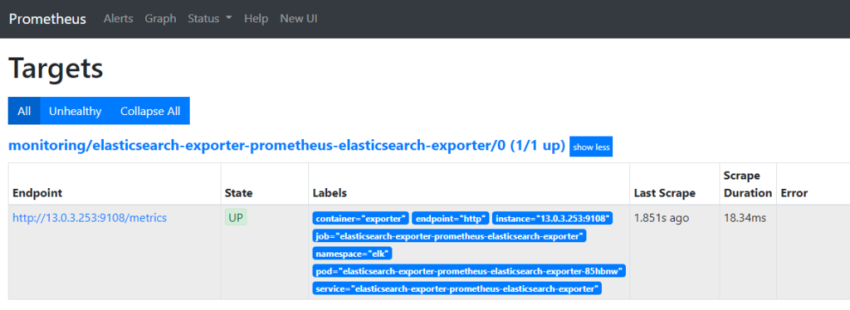
4.exporter rabbitmq
прогоняем label по всем namespace
kubectl label namespace —all «prometheus=enabled»
у меня уже установлен rabbitmq в кластере в namespace rabbitmq, прометеус в namespace monitoring
пароль от rabbitmq у меня закрыт в секрете:
kubectl get secrets -n rabbitmq | grep pass
secret-admin-password Opaque 1 4d22h
vim prometheus-rabbitmq-exporter/values.yaml
loglevel: info
rabbitmq:
url: http://rabbitmq-headless.rabbitmq.svc.test.local:15672
user: admin
password: secret-admin-password
# If existingPasswordSecret is set then password is ignored
existingPasswordSecret: ~
prometheus:
monitor:
enabled: true
additionalLabels:
release: prometheus
interval: 15s
namespace: []
helm install rabbitmq-exporter prometheus-rabbitmq-exporter/ -n monitoring —values prometheus-rabbitmq-exporter/values.yaml
5. exporter redis
прогоняем label по всем namespace
kubectl label namespace —all «prometheus=enabled»
у меня уже установлен redis в кластере в namespace redis, прометеус в namespace monitoring
пароль от redis у меня закрыт в секрете:
[root@prod-vsrv-kubemaster1 charts]# kubectl get secrets -n redis | grep -E 'NAME|password'
NAME TYPE DATA AGE
redis-password Opaque 1 27h
vim prometheus-redis-exporter/values.yaml
redisAddress: redis://redis-cluster-headless.redis.svc.test.local:6379
serviceMonitor:
enabled: true
namespace: monitoring
# Set labels for the ServiceMonitor, use this to define your scrape label for Prometheus Operator
labels:
release: prometheus
auth:
# Use password authentication
enabled: true
# Use existing secret (ignores redisPassword)
secret:
name: redis-password
key: redis-password
helm install redis-exporter prometheus-redis-exporter/ -n redis —values prometheus-redis-exporter/values.yaml
6. настройка оповещений в telegram
Для начала создадим telegram bot
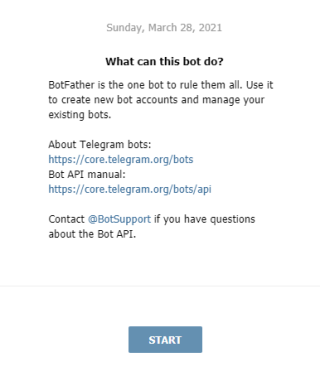
идём на @BotFather
нажимаем start и получаем список команд:
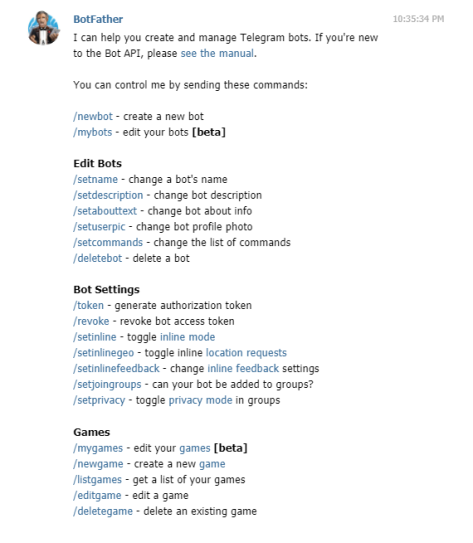
/newbot — отправляем ему и бот просит придумать имя нашему новому боту. Единственное ограничение на имя — оно должно оканчиваться на «bot». В случае успеха BotFather возвращает токен бота и ссылку для быстрого добавления бота в контакты, иначе придется поломать голову над именем.
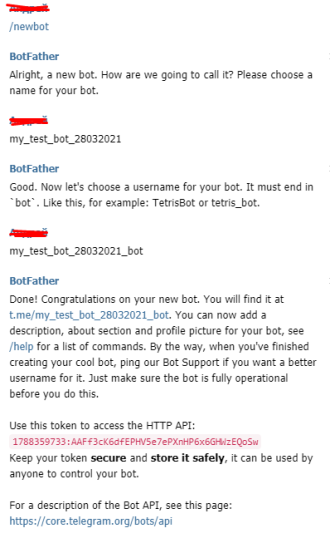
всё мы зарегались, теперь этот токен можно использовать при подключении нашего алертменеджера к телеграму
cat default.tmpl
{{ define "telegram.default" }}
{{ range .Alerts }}
{{ if eq .Status "firing"}}? <b>{{ .Status | toUpper }}</b> ? {{ else }}<b>{{ .Status | toUpper }}</b>{{ end }}
<b>{{ .Labels.alertname }}</b>
{{ .Annotations.message }} {{ .Annotations.description }}
<b>Duration:</b> {{ duration .StartsAt .EndsAt }}{{ if ne .Status "firing"}}
<b>Ended:</b> {{ .EndsAt | since }}{{ end }}
{{ end }}
{{ end }}
cat Dockerfile
FROM metalmatze/alertmanager-bot:0.4.2
COPY ./default.tmpl /templates/default.tmpl
собираем образ пушим в наш гитлаб
далее идём в телеграмм в канал:
userinfobot
печатаем старт и получаем наш id
далее выполняем:
echo -n «4196184» | base64
получаем хэш
NDE5NjE4NA==
а так же получаем хэш нашего телеграм токена:
echo -n «1788359733:AAFf3cK6dfEPHV5e7ePXnHP6x6GHWzEQoSw» | base64
MTc4ODM1OTczMzpBQUZmM2NLNmRmRVBIVjVlN2VQWG5IUDZ4NkdIV3pFUW9Tdw==
создаём deployment
cat telegrambot.yml
apiVersion: v1
items:
- apiVersion: v1
data:
admin1: NDE5NjE4NA
admin2: NTY
admin3: NDE5
token: MTc4ODM1OTczMzpBQUZmM2NLNmRmRVBIVjVlN2VQWG5IUDZ4NkdIV3pFUW9Tdw==
kind: Secret
metadata:
labels:
app.kubernetes.io/name: alertmanager-bot
name: alertmanager-bot
namespace: monitoring
type: Opaque
- apiVersion: v1
kind: Service
metadata:
labels:
app.kubernetes.io/name: alertmanager-bot
name: alertmanager-bot
namespace: monitoring
spec:
ports:
- name: http
port: 8080
targetPort: 8080
selector:
app.kubernetes.io/name: alertmanager-bot
- apiVersion: apps/v1
kind: StatefulSet
metadata:
labels:
app.kubernetes.io/name: alertmanager-bot
name: alertmanager-bot
namespace: monitoring
spec:
podManagementPolicy: OrderedReady
replicas: 1
selector:
matchLabels:
app.kubernetes.io/name: alertmanager-bot
serviceName: alertmanager-bot
template:
metadata:
labels:
app.kubernetes.io/name: alertmanager-bot
name: alertmanager-bot
namespace: monitoring
spec:
containers:
- args:
- --alertmanager.url=http://alertmanager-operated:9093
- --log.level=info
- --store=bolt
- --bolt.path=/data/bot.db
- --telegram.admin=4196184
- --telegram.admin=56
- --telegram.admin=41
env:
# - name: TELEGRAM_ADMIN
# valueFrom:
# secretKeyRef:
# key: admin
# name: alertmanager-bot
- name: TELEGRAM_TOKEN
valueFrom:
secretKeyRef:
key: token
name: alertmanager-bot
image: gitlab.test.local:4567/monitoring/alertbot
imagePullPolicy: IfNotPresent
name: alertmanager-bot
ports:
- containerPort: 8080
name: http
resources:
limits:
cpu: 100m
memory: 128Mi
requests:
cpu: 25m
memory: 64Mi
volumeMounts:
- mountPath: /data
name: alertmanager-bot
restartPolicy: Always
imagePullSecrets:
- name: regcred
volumeClaimTemplates:
- metadata:
labels:
app.kubernetes.io/name: alertmanager-bot
name: alertmanager-bot
namespace: monitoring
spec:
accessModes:
- ReadWriteMany
resources:
requests:
storage: 1Gi
storageClassName: nfs-storageclass
kind: List
admin1 — тут указываю хэши id пользователей которые будут заходить
token — тут указываем токен нашего телеграм бота (хэш)
namespace — тут указываем неймспейс в котором у нас запущен prometheus
image — тут указываем образ телеграмбота пересобранного и загруженного в наш гитлаб
— —telegram.admin — тут id пользователей в открытом виде
можем запускать:
kubectl apply -f telegrambot.yml
всё можно проверять:
пишем /start
и бот отвечает:

6.1 настройка оповещений в telegram, в различные чаты(группы)
Задача — настроить оповещения в разные чаты телеграмма
за основу будет взят телеграм бот:
https://github.com/inCaller/prometheus_bot
который был заточен под helm chart
https://github.com/gvych/telegram-bot-helm-chart
отмечу сразу что его надо дописывать в values так как с нуля он не стартует.
приступим, создаём в телеграм новую группу:
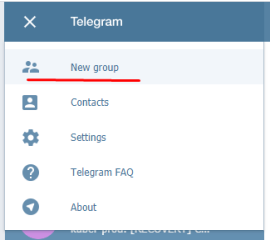
добавляем нашего бота которого мы создали в предыдущем пункте, так как я дополняю статью позже, то имя бота у меня другое:
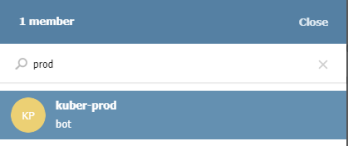
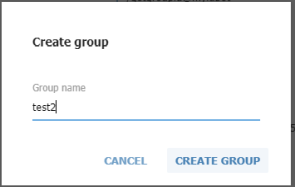
далее добавляем к группе бота который позволит увидеть chatid
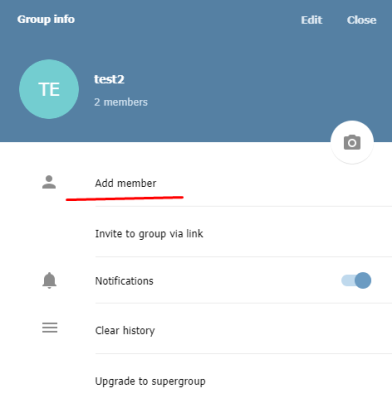
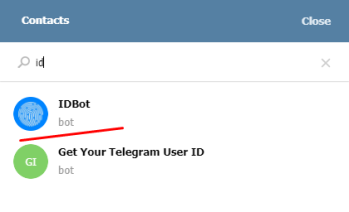


вот мы получили chatid запомним его.
Выкачиваем репозиторий:
git clone https://github.com/gvych/telegram-bot-helm-chart.git
cd telegram-bot-helm-chart
правим версию для deployment и выславляем selector изначально их нету в гите, общий вид будет такой:
cat telegram-bot/templates/deployment.yaml
{{- if not .Values.application.initializeCommand -}}
apiVersion: apps/v1
kind: Deployment
metadata:
name: {{ template "trackableappname" . }}
labels:
app: {{ template "appname" . }}
track: "{{ .Values.application.track }}"
tier: "{{ .Values.application.tier }}"
chart: "{{ .Chart.Name }}-{{ .Chart.Version | replace "+" "_" }}"
release: {{ .Release.Name }}
heritage: {{ .Release.Service }}
spec:
replicas: {{ .Values.replicaCount }}
selector:
matchLabels:
app: {{ template "appname" . }}
template:
metadata:
annotations:
checksum/application-secrets: "{{ .Values.application.secretChecksum }}"
labels:
app: {{ template "appname" . }}
track: "{{ .Values.application.track }}"
tier: "{{ .Values.application.tier }}"
release: {{ .Release.Name }}
spec:
imagePullSecrets:
{{ toYaml .Values.image.secrets | indent 10 }}
volumes:
- configMap:
defaultMode: 420
name: {{ template "trackableappname" . }}.config
name: config-volume
containers:
- name: {{ .Chart.Name }}
image: "moghaddas/prometheus_bot"
imagePullPolicy: {{ .Values.image.pullPolicy }}
volumeMounts:
- mountPath: /config.yaml
name: config-volume
subPath: config.yaml
- mountPath: /alert.tmpl
name: config-volume
subPath: alert.tmpl
ports:
- name: "{{ .Values.service.name }}"
containerPort: {{ .Values.service.internalPort }}
livenessProbe:
tcpSocket:
port: {{ .Values.service.internalPort }}
initialDelaySeconds: {{ .Values.livenessProbe.initialDelaySeconds }}
timeoutSeconds: {{ .Values.livenessProbe.timeoutSeconds }}
readinessProbe:
tcpSocket:
port: {{ .Values.service.internalPort }}
initialDelaySeconds: {{ .Values.readinessProbe.initialDelaySeconds }}
timeoutSeconds: {{ .Values.readinessProbe.timeoutSeconds }}
resources:
{{ toYaml .Values.resources | indent 12 }}
{{- end -}}
также правим конфиг, чтобы в уведомлении видно было alertname, description, message — по умолчанию их нету в дефолте.
telegram-bot-helm/templates/configmap.yaml
apiVersion: v1
kind: ConfigMap
metadata:
name: {{ template "trackableappname" . }}.config
labels:
app: {{ template "appname" . }}
chart: "{{ .Chart.Name }}-{{ .Chart.Version | replace "+" "_" }}"
release: {{ .Release.Name }}
heritage: {{ .Release.Service }}
data:
config.yaml: |-
telegram_token: "{{ .Values.telegram.token }}"
template_path: "/alert.tmpl"
time_zone: "UTC"
split_token: "|"
split_msg_byte: 4000
alert.tmpl: |-
{{ "{{" }} if eq .Status "firing" {{ "}}" }} <b>[PROBLEM]</b> {{ "{{" }} else {{ "}}" }} <b>[RECOVERY]</b> {{ "{{" }} end {{ "}}" }}
{{ "{{" }} index (index .Alerts 0).Labels "alertname" {{ "}}" }}
{{ "{{" }} index (index .Alerts 0).Annotations "description"{{ "}}" }}
{{ "{{" }} index (index .Alerts 0).Annotations "message"{{ "}}" }}
теперь правим файл с переменными:
cat telegram-bot/values.yaml
# Default values for chart.
# This is a YAML-formatted file.
# Declare variables to be passed into your templates.
replicaCount: 1
telegram:
token: "139453456058954:AAFaZIepDdfggTql0dfgdfPT6dq1Edqu5dfggxFD6Wr08j0g"
chat_id: "-567616984" #not used at the moment
releaseOverride: alertmanager-bot-chat-id
image:
pullPolicy: Always
application:
track: stable
tier: web
migrateCommand:
initializeCommand:
secretName:
secretChecksum:
service:
enabled: true
name: web
type: ClusterIP
url: http://alertmanager-operated:9093
additionalHosts:
commonName:
externalPort: 9087
internalPort: 9087
livenessProbe:
initialDelaySeconds: 15
readinessProbe:
initialDelaySeconds: 5
resources:
limits:
cpu: 100m
memory: 128Mi
requests:
cpu: 10m
memory: 8Mi
здесь token — это токен нашего телеграм бота мы его получаем при его регистрации в botfather
chat_id — это id нашей группы
url: http://alertmanager-operated:9093 это наш адрес alermanager увидеть его можно следующим образом:
kubectl get service -n monitoring | grep alertmanager-operated
alertmanager-operated ClusterIP None <none> 9093/TCP,9094/TCP,9094/UDP 57d
для каждой группы мы будем запускать свой телеграмбот, вот второй:
cat telegram-bot/values-test.yaml
# Default values for chart.
# This is a YAML-formatted file.
# Declare variables to be passed into your templates.
replicaCount: 1
telegram:
token: "139453456058954:AAFaZIepDdfggTql0dfgdfPT6dq1Edqu5dfggxFD6Wr08j0g"
chat_id: "-480100545" #not used at the moment
releaseOverride: alertmanager-bot-test
image:
pullPolicy: Always
application:
track: stable
tier: web
migrateCommand:
initializeCommand:
secretName:
secretChecksum:
service:
enabled: true
name: web
type: ClusterIP
url: http://alertmanager-operated:9093
additionalHosts:
commonName:
externalPort: 9087
internalPort: 9087
livenessProbe:
initialDelaySeconds: 15
readinessProbe:
initialDelaySeconds: 5
resources:
limits:
cpu: 100m
memory: 128Mi
requests:
cpu: 10m
memory: 8Mi
ставим первый:
helm upgrade —install -name telegram-bot-chat-id telegram-bot/ -f telegram-bot/values.yaml —namespace monitoring
и второй:
helm upgrade —install -name telegram-bot-test telegram-bot/ -f telegram-bot/values-test.yaml —namespace monitoring
далее создаём своё кастомное правило:
cat prometheus-alert-rule.yaml
apiVersion: monitoring.coreos.com/v1
kind: PrometheusRule
metadata:
annotations:
meta.helm.sh/release-name: prometheus
meta.helm.sh/release-namespace: monitoring
prometheus-operator-validated: "true"
labels:
app: kube-prometheus-stack
release: prometheus
name: my-test-prometheus-alertmanager.rules
namespace: monitoring
selfLink: /apis/monitoring.coreos.com/v1/namespaces/monitoring/prometheusrules/my-test-prometheus-alertmanager.rules
spec:
groups:
- name: my-test-alertmanager.rules
rules:
- alert: EBNULSA_CONTAINER
annotations:
message: |
CONTAINER_UMER
Namespace: {{ $labels.namespace }} and
Podname: {{ $labels.pod }}
expr: sum_over_time(kube_pod_container_status_ready{namespace="my-site"}[5m])
<1
for: 1m
labels:
severity: critical
team: namespace-my-site
и второе:
cat prometheus-alert-rule-test.yaml
apiVersion: monitoring.coreos.com/v1
kind: PrometheusRule
metadata:
annotations:
meta.helm.sh/release-name: prometheus
meta.helm.sh/release-namespace: monitoring
prometheus-operator-validated: "true"
labels:
app: kube-prometheus-stack
release: prometheus
name: test-prometheus-alertmanager.rules
namespace: monitoring
selfLink: /apis/monitoring.coreos.com/v1/namespaces/monitoring/prometheusrules/test-prometheus-alertmanager.rules
spec:
groups:
- name: test-alertmanager.rules
rules:
- alert: EBNULSA_CONTAINER-namespace-test
annotations:
message: |
CONTAINER_UMER
Namespace: {{ $labels.namespace }} and
Podname: {{ $labels.pod }}
expr: sum_over_time(kube_pod_container_status_ready{namespace="test"}[5m])
<1
for: 1m
labels:
severity: critical
team: namespace-test
тут обращаем внимание на разное название лейблов
team: namespace-my-site
и
team: namespace-test
согласно данным лейблам алертменеджер будет раскидывать в нужные группы.
смотрим что данные правила создались:
kubectl -n monitoring get prometheusrules.monitoring.coreos.com
NAME AGE
my-test-prometheus-alertmanager.rules 19h
prometheus-kube-prometheus-alertmanager.rules 57d
prometheus-kube-prometheus-etcd 57d
prometheus-kube-prometheus-general.rules 57d
prometheus-kube-prometheus-k8s.rules 57d
prometheus-kube-prometheus-kube-apiserver-availability.rules 57d
prometheus-kube-prometheus-kube-apiserver-slos 57d
prometheus-kube-prometheus-kube-apiserver.rules 57d
prometheus-kube-prometheus-kube-prometheus-general.rules 57d
prometheus-kube-prometheus-kube-prometheus-node-recording.rules 57d
prometheus-kube-prometheus-kube-scheduler.rules 57d
prometheus-kube-prometheus-kube-state-metrics 57d
prometheus-kube-prometheus-kubelet.rules 57d
prometheus-kube-prometheus-kubernetes-apps 57d
prometheus-kube-prometheus-kubernetes-resources 57d
prometheus-kube-prometheus-kubernetes-storage 57d
prometheus-kube-prometheus-kubernetes-system 57d
prometheus-kube-prometheus-kubernetes-system-apiserver 57d
prometheus-kube-prometheus-kubernetes-system-controller-manager 57d
prometheus-kube-prometheus-kubernetes-system-kubelet 57d
prometheus-kube-prometheus-kubernetes-system-scheduler 57d
prometheus-kube-prometheus-node-exporter 57d
prometheus-kube-prometheus-node-exporter.rules 57d
prometheus-kube-prometheus-node-network 57d
prometheus-kube-prometheus-node.rules 57d
prometheus-kube-prometheus-prometheus 57d
prometheus-kube-prometheus-prometheus-operator 57d
test-prometheus-alertmanager.rules 18h

далее правим конфиг алертменеджера, не забываем что в нашем случае это гит:
https://github.com/prometheus-community/helm-charts.git
правим файл:
helm-charts/charts/kube-prometheus-stack/values.yaml
alertmanager:
## Deploy alertmanager
enabled: true
apiVersion: v2
serviceAccount:
create: true
name: ""
annotations: {}
podDisruptionBudget:
enabled: false
minAvailable: 1
maxUnavailable: ""
config:
global:
resolve_timeout: 5m
smtp_smarthost: 10.230.144.56:25
route:
# receiver: 'telegram'
receiver: 'email_unixadmins'
routes:
- receiver: "telegram"
group_wait: 10s
repeat_interval: 48h
match_re:
severity: "critical|warning"
continue: true
- receiver: "telegram"
group_wait: 10s
repeat_interval: 48h
match_re:
alertname: "Watchdog"
continue: true
- receiver: "email_unixadmins"
group_wait: 10s
repeat_interval: 48h
match_re:
severity: "critical"
continue: true
- receiver: "telegram-my-site"
match_re:
severity: "critical"
team: "namespace-my-site"
- receiver: "telegram-test"
match_re:
severity: "critical"
team: "namespace-test"
receivers:
- name: 'telegram'
webhook_configs:
- send_resolved: true
# url: 'http://alertmanager-bot:8080'
url: 'http://alertmanager-bot-chat-id:9087/alert/-567616984'
- name: 'telegram-my-site'
webhook_configs:
- send_resolved: true
url: 'http://alertmanager-bot-for-my-site:9087/alert/-581835428'
- name: 'telegram-test'
webhook_configs:
- send_resolved: true
url: 'http://alertmanager-bot-test:9087/alert/-480100545'
- name: 'email_unixadmins'
email_configs:
- to: 'admin1@test.ru'
from: 'prod-vsrv-kuber-alertmanager@test.ru'
require_tls: false
send_resolved: true
- to: 'admin2@test.ru'
from: 'prod-vsrv-kuber-alertmanager@test.ru'
require_tls: false
send_resolved: true
обращаю внимание, что установить несколько типов severity можно в таком виде:
severity: «critical|warning»
запись вида:
continue: true
(по умолчанию она false) означает что после первого совпадения надо продолжать роутить сообщения
всё дальше можно апдейтить:
helm upgrade —install -name prometheus kube-prometheus-stack/ -f kube-prometheus-stack/values.yaml —namespace monitoring
6.2. настройка оповещений в telegram разграничение оповещений по группам (исключения уведомлений)
Вводная: есть админский чат и есть чат разработчиков. при настройке как в пункте 6.1 уведомления приходящие в чат разрабочиков дублируются и в чат админов.
данная ситуация происходит вообще потому, что alertmanager со следующим конфигом:
config:
global:
resolve_timeout: 5m
smtp_smarthost: 10.230.144.56:25
route:
# receiver: 'telegram'
receiver: 'email_unixadmins'
routes:
- receiver: "telegram-admins"
group_wait: 10s
repeat_interval: 1h
match_re:
severity: "critical|warning"
continue: true
- receiver: "telegram-admins"
group_wait: 10s
repeat_interval: 48h
match_re:
alertname: "Watchdog"
continue: true
- receiver: "telegram-terminal-soft"
group_wait: 10s
repeat_interval: 1h
match_re:
severity: "critical"
team: "terminal-soft"
continue: true
имеет настройку
continue: true (по дефолту false)
благодаря которой уведомления попав под первое правило не прекращаются а отправляются дальше по route и отправляются по другим receiver (когда совпадают по label)
ВАЖНО!!!!!!!!!!!!!! в записи:
match_re:
severity: "critical"
team: "terminal-soft"
правила совпадения работают не как OR а как AND (т.е. должны совпасть ВСЕ лейблы)
Задача, исключить из чата админов сообщения отправляемые в чат разрабочиков, чтобы админам прилетали все дефолтные
Решение — возможно тупенькое но я другого не нашёл, работать будет так:
прилетает сообщение, с лейблами:
severity: «critical»
team: «terminal-soft»
значит оно должно попасть только в группу terminal-soft, поэтому для receiver: «telegram-terminal-soft» оставляем
match_re:
team: «terminal-soft»
но так как в уведомлении будет прителать лейбл
severity: «critical» то он будет попадать под совпадение receiver: «telegram-admins» у которого
match_re:
severity: «critical|warning»
нам этого не нужно поэтому для
receiver: «telegram-terminal-soft»
ставим continue: false и тогда обработка следующих routes не будет происходить.
вывод перед админским чатом правило должно быть с условием:
continue: false
а админский чат последний в списке.
теперь рассмотрим всё это по конфигам:
правило по которому будет срабатывать алерт:
test.rule.yml
apiVersion: monitoring.coreos.com/v1
kind: PrometheusRule
metadata:
annotations:
meta.helm.sh/release-name: prometheus
meta.helm.sh/release-namespace: monitoring
prometheus-operator-validated: "true"
labels:
app: kube-prometheus-stack
release: prometheus
name: mega-mega24-cloud-prometheus-alertmanager.rules
namespace: monitoring
selfLink: /apis/monitoring.coreos.com/v1/namespaces/monitoring/prometheusrules/mega-mega24-cloud-prometheus-alertmanager.rules
spec:
groups:
- name: mega-mega24-cloud-alertmanager.rules
rules:
- alert: EBNULSA_CONTAINER
annotations:
message: |
CONTAINER_UMER
Namespace: {{ $labels.namespace }} and
Podname: {{ $labels.pod }}
expr: sum_over_time(kube_pod_container_status_ready{namespace="mega-mega24-cloud"}[2m])
<1
for: 1m
labels:
team: "terminal-soft"
тут обращаем внимание на наличие лейбла team: «terminal-soft» и отсутствие лейбла severity: critical
конфиг алерт менеджера:
cat helm-charts/charts/kube-prometheus-stack/values.yaml
## Alertmanager configuration directives
## ref: https://prometheus.io/docs/alerting/configuration/#configuration-file
## https://prometheus.io/webtools/alerting/routing-tree-editor/
##
config:
global:
resolve_timeout: 5m
smtp_smarthost: 10.230.144.56:25
route:
# receiver: 'telegram'
receiver: 'email_unixadmins'
routes:
- receiver: "email_unixadmins"
group_wait: 10s
repeat_interval: 48h
match_re:
severity: "critical"
continue: true
- receiver: "telegram-admins"
group_wait: 10s
repeat_interval: 48h
match_re:
alertname: "Watchdog"
continue: true
- receiver: "telegram-terminal-soft"
group_wait: 10s
repeat_interval: 1h
match_re:
team: "terminal-soft"
continue: false
- receiver: "telegram-admins"
group_wait: 10s
repeat_interval: 1h
match_re:
severity: "critical|warning"
continue: true
receivers:
- name: 'telegram-admins'
webhook_configs:
- send_resolved: true
url: 'http://telegram-admins-group:9087/alert/-1001441100259'
- name: 'telegram-terminal-soft'
webhook_configs:
- send_resolved: true
url: 'http://telegram-terminal-soft:9087/alert/-597056946'
- name: 'email_unixadmins'
email_configs:
- to: 'user1@test.ru'
from: 'prod-vsrv-kuber-alertmanager@test.ru'
require_tls: false
send_resolved: true
- to: 'user2@test.ru'
from: 'prod-vsrv-kuber-alertmanager@test.ru'
require_tls: false
send_resolved: true
тут видим что предпоследнее правило имеет вид:
— receiver: «telegram-terminal-soft»
group_wait: 10s
repeat_interval: 1h
match_re:
team: «terminal-soft»
continue: false
а последнее правило для работы дефолтных правил (которые есть в prometheus по умолчанию)
— receiver: «telegram-admins»
group_wait: 10s
repeat_interval: 1h
match_re:
severity: «critical|warning»
continue: true
7.Проблема с prometheus-kube-proxy
столкнулся со следующей проблемой, после запуска прометеуса не отображаются метрики с kube-proxy

прикол в следующем, сам kube-proxy стартанул на 127,0,0,1
[root@kub-worker-2 ~]# netstat -ntpl | grep 10249
tcp 0 0 127.0.0.1:10249 0.0.0.0:* LISTEN 2537/kube-proxy
а прометеус лезет на айпишник т.е. щимится на ноды а там ни кто не отвечает:
[root@kub-master-1 charts]# telnet 192.168.1.205 10249
Trying 192.168.1.205…
telnet: connect to address 192.168.1.205: Connection refused
что для исправления делаем, НА ВСЕХ НОДАХ правим:
[root@kub-master-1 charts]# vim /etc/kubernetes/kube-proxy-config.yaml
c
metricsBindAddress: 127.0.0.1:10249
на
metricsBindAddress: 0.0.0.0:10249
общий вид у файла такой:
apiVersion: kubeproxy.config.k8s.io/v1alpha1
kind: KubeProxyConfiguration
bindAddress: 0.0.0.0
clientConnection:
acceptContentTypes:
burst: 10
contentType: application/vnd.kubernetes.protobuf
kubeconfig: /etc/kubernetes/kube-proxy-kubeconfig.yaml
qps: 5
clusterCIDR: 10.0.0.0/16
configSyncPeriod: 15m0s
conntrack:
maxPerCore: 32768
min: 131072
tcpCloseWaitTimeout: 1h0m0s
tcpEstablishedTimeout: 24h0m0s
enableProfiling: False
healthzBindAddress: 127.0.0.1
hostnameOverride: kub-master-1
iptables:
masqueradeAll: False
masqueradeBit: 14
minSyncPeriod: 0s
syncPeriod: 30s
ipvs:
excludeCIDRs: []
minSyncPeriod: 0s
scheduler: rr
syncPeriod: 30s
strictARP: False
metricsBindAddress: 0.0.0.0:10249
mode: iptables
nodePortAddresses: []
oomScoreAdj: -999
portRange:
udpIdleTimeout: 250ms
далее перезапускаем:
[root@kub-master-1 charts]# kubectl delete pod -n kube-system kube-proxy-kub-master-1 kube-proxy-kub-master-2 kube-proxy-kub-master-3 kube-proxy-kub-worker-1 kube-proxy-kub-worker-2
pod «kube-proxy-kub-master-1» deleted
pod «kube-proxy-kub-master-2» deleted
pod «kube-proxy-kub-master-3» deleted
pod «kube-proxy-kub-worker-1» deleted
pod «kube-proxy-kub-worker-2» deleted
Проверяем доступность:
[root@kub-master-1 charts]# telnet 192.168.1.205 10249
Trying 192.168.1.205…
Connected to 192.168.1.205.
Escape character is ‘^]’.
^]
telnet> quit
Connection closed.
и как видим метрики теперь отображаются:

8.Настройка алерта для определённого namespace
У меня есть тестовый сервис:
cat my-site-ingress.yaml
---
apiVersion: extensions/v1beta1
kind: Ingress
metadata:
name: my-ingress
namespace: my-site
spec:
rules:
- host: test.ru #тут указывается наш домен
http:
paths: #список путей которые хотим обслуживать(он дефолтный и все запросы будут отправляться на бэкенд, т.е. на сервис my-service-apache)
- backend:
serviceName: my-service-apache #тут указывается наш сервис
servicePort: 80 #порт на котором сервис слушает
# path: / все запросы на корень '/' будут уходить на наш сервис
cat my-site-service.yaml
---
apiVersion: v1
kind: Service
metadata:
name: my-service-apache # имя сервиса
namespace: my-site
spec:
ports:
- port: 80 # принимать на 80
targetPort: 80 # отправлять на 80
selector:
app: apache #отправлять на все поды с данным лейблом
type: ClusterIP
cat my-site.yaml
---
apiVersion: apps/v1
kind: Deployment
metadata:
name: my-deployment-apache
namespace: my-site
spec:
replicas: 1
selector:
matchLabels:
app: apache # по вот этому лейблу репликасет цепляет под
# тут описывается каким мокаром следует обновлять поды
strategy:
rollingUpdate:
maxSurge: 1 # указывает на какое количество реплик можно увеличить
maxUnavailable: 1 # указывает на какое количество реплик можно уменьшить
#т.е. в одно время при обновлении, будет увеличено на один (новый под) и уменьшено на один (старый под)
type: RollingUpdate
## тут начинается описание контейнера
template:
metadata:
labels:
app: apache # по вот этому лейблу репликасет цепляет под
spec:
containers:
- image: httpd:2.4.43
name: apache
ports:
- containerPort: 80
# тут начинаются проверки по доступности
readinessProbe: # проверка готово ли приложение
failureThreshold: 3 #указывает количество провалов при проверке
httpGet: # по сути дёргает курлом на 80 порт
path: /
port: 80
periodSeconds: 10 #как часто должна проходить проверка (в секундах)
successThreshold: 1 #сбрасывает счётчик неудач, т.е. при 3х проверках если 1 раз успешно прошло, то счётчик сбрасывается и всё ок
timeoutSeconds: 1 #таймаут на выполнение пробы 1 секунда
livenessProbe: #проверка на жизнь приложения, живо ли оно
failureThreshold: 3
httpGet:
path: /
port: 80
periodSeconds: 10
successThreshold: 1
timeoutSeconds: 1
initialDelaySeconds: 10 #означает что первую проверку надо сделать только после 10 секунд
# тут начинается описание лимитов для пода
resources:
requests: #количество ресурсов которые резервируются для pod на ноде
cpu: 60m
memory: 200Mi
limits: #количество ресурсов которые pod может использовать(верхняя граница)
cpu: 120m
memory: 300Mi
применяем
kubectl create ns my-site
kubectl apply -f my-site-ingress.yaml -f my-site-service.yaml -f my-site.yaml
проверяем
[root@kub-master-1 ~]# kubectl get pod -n my-site
NAME READY STATUS RESTARTS AGE
my-deployment-apache-859486bd8c-zk99f 1/1 Running 0 11m
как видим всё ок.
теперь сделаем так чтобы сервис постоянно падал и перезапускался, для этого подправим в деплойменте проверки(readinessProbe/livenessProbe) порта не 80 а 81:
cat my-site.yaml
---
apiVersion: apps/v1
kind: Deployment
metadata:
name: my-deployment-apache
namespace: my-site
spec:
replicas: 1
selector:
matchLabels:
app: apache # по вот этому лейблу репликасет цепляет под
# тут описывается каким мокаром следует обновлять поды
strategy:
rollingUpdate:
maxSurge: 1 # указывает на какое количество реплик можно увеличить
maxUnavailable: 1 # указывает на какое количество реплик можно уменьшить
#т.е. в одно время при обновлении, будет увеличено на один (новый под) и уменьшено на один (старый под)
type: RollingUpdate
## тут начинается описание контейнера
template:
metadata:
labels:
app: apache # по вот этому лейблу репликасет цепляет под
spec:
containers:
- image: httpd:2.4.43
name: apache
ports:
- containerPort: 80
# тут начинаются проверки по доступности
readinessProbe: # проверка готово ли приложение
failureThreshold: 3 #указывает количество провалов при проверке
httpGet: # по сути дёргает курлом на 80 порт
path: /
port: 81
periodSeconds: 10 #как часто должна проходить проверка (в секундах)
successThreshold: 1 #сбрасывает счётчик неудач, т.е. при 3х проверках если 1 раз успешно прошло, то счётчик сбрасывается и всё ок
timeoutSeconds: 1 #таймаут на выполнение пробы 1 секунда
livenessProbe: #проверка на жизнь приложения, живо ли оно
failureThreshold: 3
httpGet:
path: /
port: 81
periodSeconds: 10
successThreshold: 1
timeoutSeconds: 1
initialDelaySeconds: 10 #означает что первую проверку надо сделать только после 10 секунд
# тут начинается описание лимитов для пода
resources:
requests: #количество ресурсов которые резервируются для pod на ноде
cpu: 60m
memory: 200Mi
limits: #количество ресурсов которые pod может использовать(верхняя граница)
cpu: 120m
memory: 300Mi
и применим:
kubectl apply -f my-site.yaml
как видим pod перезапускается:
[root@kub-master-1 ~]# kubectl get pod -n my-site
NAME READY STATUS RESTARTS AGE
my-deployment-apache-85978bf68f-mbwlm 0/1 Running 1 41s
но не может пройти проверки.
посмотрим что в метриках на prometheus:
применим promql запрос:
kube_pod_container_status_ready{namespace=»my-site»}[5m]
который смотрит статус контейнеров по namespace my-site за последние 5 минут.

как видим у нас 2 разных имени контейнера:
my-deployment-apache-859486bd8c-zk99f (который был запущен ранее и с ним было всё нормально)
и
my-deployment-apache-85978bf68f-mbwlm (текущий, который был специально сломан через неправильные проверки)
теперь нам надо получить результат, были ли за последние 5 минуть незапущенные контейнеры, для этого используем следующий запрос:
sum_over_time(kube_pod_container_status_ready{namespace=»my-site»}[5m]) <1
который смотрит были ли контейнеры со статусом МЕНЬШЕ 1 (т.е. не запущенные) за 5 минут

для проверки можем увеличить время до 900 минут и глянем что он выведет:

как видим таких было 3 контейнера
возвращаем проверки в деплойменте ждём 5 минут и проверяем статус:

как видим за 5 минут упавших контейнеров не было.
теперь привяжем это к alertmanager.
правим имеющееся правила прометеуса:
kubectl -n monitoring edit prometheusrules prometheus-kube-prometheus-alertmanager.rules
и в общий список где перечисляются правила:
spec:
groups:
- name: alertmanager.rules
rules:
- alert: AlertmanagerConfigInconsistent
annotations:
message: |
The configuration of the instances of the Alertmanager cluster `{{ $labels.namespace }}/{{ $labels.service }}` are out of sync.
{{ range printf "alertmanager_config_hash{namespace="%s",service="%s"}" $labels.namespace $labels.service | query }}
Configuration hash for pod {{ .Labels.pod }} is "{{ printf "%.f" .Value }}"
{{ end }}
expr: count by(namespace,service) (count_values by(namespace,service) ("config_hash",
alertmanager_config_hash{job="prometheus-kube-prometheus-alertmanager",namespace="monitoring"}))
!= 1
for: 5m
labels:
severity: critical
- alert: AlertmanagerFailedReload
annotations:
message: Reloading Alertmanager's configuration has failed for {{ $labels.namespace
}}/{{ $labels.pod}}.
expr: alertmanager_config_last_reload_successful{job="prometheus-kube-prometheus-alertmanager",namespace="monitoring"}
== 0
for: 10m
labels:
severity: warning
- alert: AlertmanagerMembersInconsistent
annotations:
message: Alertmanager has not found all other members of the cluster.
expr: |-
alertmanager_cluster_members{job="prometheus-kube-prometheus-alertmanager",namespace="monitoring"}
!= on (service) GROUP_LEFT()
count by (service) (alertmanager_cluster_members{job="prometheus-kube-prometheus-alertmanager",namespace="monitoring"})
for: 5m
labels:
severity: critical
добавляем наше:
- alert: EBNULSA_CONTAINER
annotations:
message: CONTAINER_UMER
expr: sum_over_time(kube_pod_container_status_ready{namespace="my-site"}[5m])
<1
for: 1m
labels:
severity: critical
выходим сохраняемся.
в прометеусе переходим на вкладку alerts и видим наше правило:

всё теперь можно снова ломать проверки в нашем деплойменте и проверять полетел ли алерт:
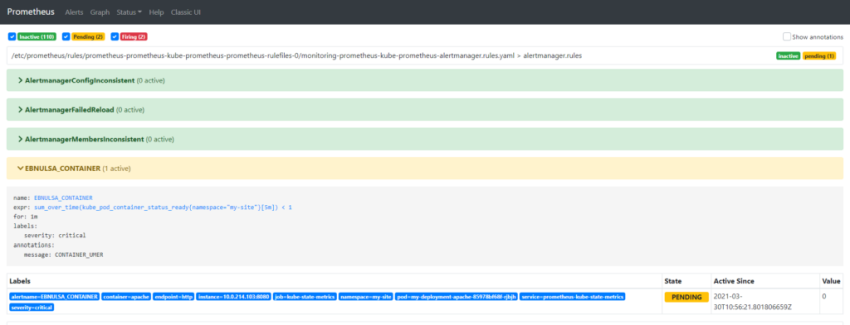
как видим полетел.
проверяем наш телеграм бот и видим:
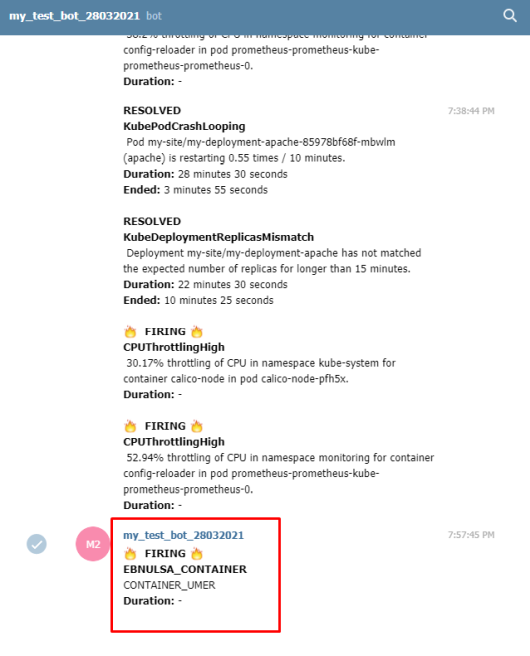
в таком вот виде настраивается алертинг.
Теперь рассмотрим как нам добавлять свой алертинг а не править имеющийся.
смотрим имеющие правила:
[root@kub-master-1 ~]# kubectl -n monitoring get prometheusrules.monitoring.coreos.com
NAME AGE
prometheus-kube-prometheus-alertmanager.rules 3d
prometheus-kube-prometheus-etcd 3d
prometheus-kube-prometheus-general.rules 3d
prometheus-kube-prometheus-k8s.rules 3d
prometheus-kube-prometheus-kube-apiserver-availability.rules 3d
prometheus-kube-prometheus-kube-apiserver-slos 3d
prometheus-kube-prometheus-kube-apiserver.rules 3d
prometheus-kube-prometheus-kube-prometheus-general.rules 3d
prometheus-kube-prometheus-kube-prometheus-node-recording.rules 3d
prometheus-kube-prometheus-kube-scheduler.rules 3d
prometheus-kube-prometheus-kube-state-metrics 3d
prometheus-kube-prometheus-kubelet.rules 3d
prometheus-kube-prometheus-kubernetes-apps 3d
prometheus-kube-prometheus-kubernetes-resources 3d
prometheus-kube-prometheus-kubernetes-storage 3d
prometheus-kube-prometheus-kubernetes-system 3d
prometheus-kube-prometheus-kubernetes-system-apiserver 3d
prometheus-kube-prometheus-kubernetes-system-controller-manager 3d
prometheus-kube-prometheus-kubernetes-system-kubelet 3d
prometheus-kube-prometheus-kubernetes-system-scheduler 3d
prometheus-kube-prometheus-node-exporter 3d
prometheus-kube-prometheus-node-exporter.rules 3d
prometheus-kube-prometheus-node-network 3d
prometheus-kube-prometheus-node.rules 3d
prometheus-kube-prometheus-prometheus 3d
prometheus-kube-prometheus-prometheus-operator 3d
добавляем наше:
cat prometheus-alert-rule.yaml
apiVersion: monitoring.coreos.com/v1
kind: PrometheusRule
metadata:
annotations:
meta.helm.sh/release-name: prometheus
meta.helm.sh/release-namespace: monitoring
prometheus-operator-validated: "true"
labels:
app: kube-prometheus-stack
release: prometheus
name: my-test-prometheus-alertmanager.rules
namespace: monitoring
selfLink: /apis/monitoring.coreos.com/v1/namespaces/monitoring/prometheusrules/my-test-prometheus-alertmanager.rules
spec:
groups:
- name: my-test-alertmanager.rules
rules:
- alert: EBNULSA_CONTAINER
annotations:
message: |
CONTAINER_UMER
Namespace: {{ $labels.namespace }} and
Podname: {{ $labels.pod }}
expr: sum_over_time(kube_pod_container_status_ready{namespace="my-site"}[5m])
<1
for: 1m
labels:
severity: critical
применяем:
[root@kub-master-1 ~]# kubectl apply -f prometheus-alert-rule.yaml
проверяем:
[root@kub-master-1 ~]# kubectl -n monitoring get prometheusrules.monitoring.coreos.com | grep my
my-test-prometheus-alertmanager.rules 91m
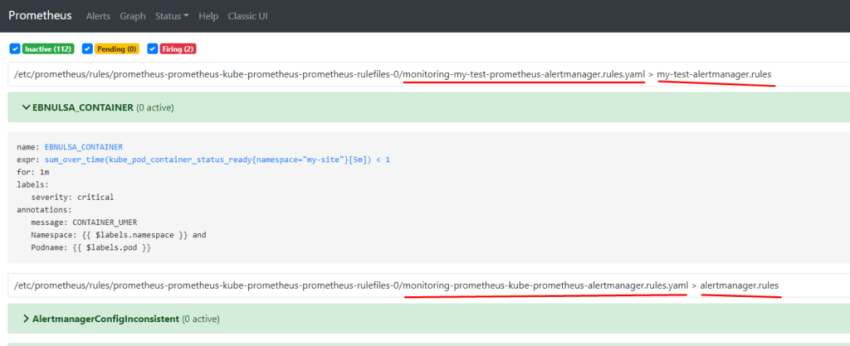
как видим наше правило добавилось.
запись вида:
Namespace: {{ $labels.namespace }}
Podname: {{ $labels.pod }}
выведет имя неймспейса и имя пода.
в телеграме это будет отображаться следующим образом:
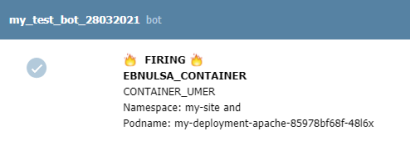
9.Добавление оповещений и по email
правим файл:
vim charts/kube-prometheus-stack/values.yaml
## Alertmanager configuration directives
## ref: https://prometheus.io/docs/alerting/configuration/#configuration-file
## https://prometheus.io/webtools/alerting/routing-tree-editor/
##
config:
global:
resolve_timeout: 5m
smtp_smarthost: 10.20.44.56:25
route:
# receiver: 'telegram'
receiver: 'email_unixadmins'
routes:
- receiver: "telegram"
group_wait: 10s
repeat_interval: 48h
match_re:
severity: "critical"
continue: true
- receiver: "telegram"
group_wait: 10s
repeat_interval: 48h
match_re:
alertname: "Watchdog"
continue: true
- receiver: "email_unixadmins"
group_wait: 10s
repeat_interval: 48h
match_re:
severity: "critical"
continue: true
receivers:
- name: 'telegram'
webhook_configs:
- send_resolved: true
url: 'http://alertmanager-bot:8080'
- name: 'email_unixadmins'
email_configs:
- to: 'admin1@test.ru'
from: 'prod-vsrv-kuber-alertmanager@test.ru'
require_tls: false
send_resolved: true
- to: 'admin2@test.ru'
from: 'prod-vsrv-kuber-alertmanager@test.ru'
require_tls: false
send_resolved: true
smtp_smarthost: 10.20.44.56:25 это наш smtp хост через который мы шлём почту.
receiver: ’email_unixadmins’ — на него будут идти оповещения вне зависимости от критичности алерта, для остальных можно выставлять уровень критичности.
и применяем:
helm upgrade —install -name prometheus kube-prometheus-stack/ -f kube-prometheus-stack/values.yaml —namespace monitoring
10. Настройка графиков в grafana
создаём новый дашборд

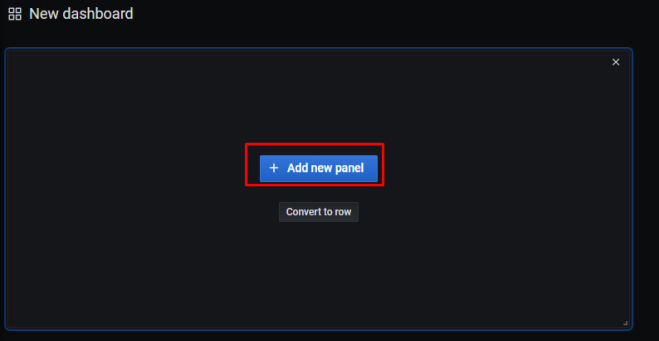
переходим к созданию панели
она будет отображать только наш неймспейс terminal-soft
создадим панель которая будет отображать сколько процессорного времени использует namespace
запрос выглядит следующим образом:
sum(rate(container_cpu_usage_seconds_total{namespace=»terminal-soft»}[5m]))
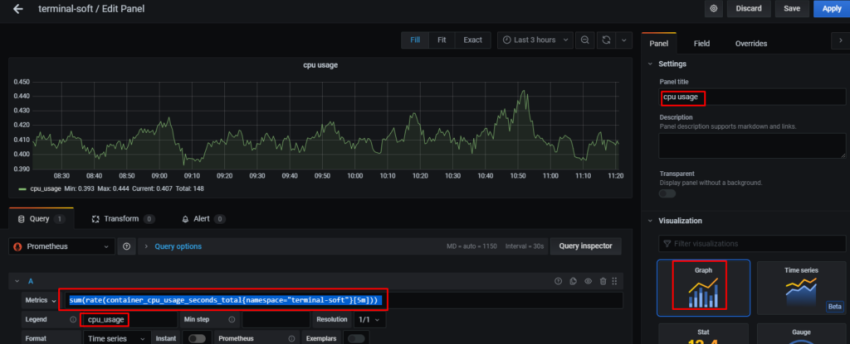
настраиваем отображение:
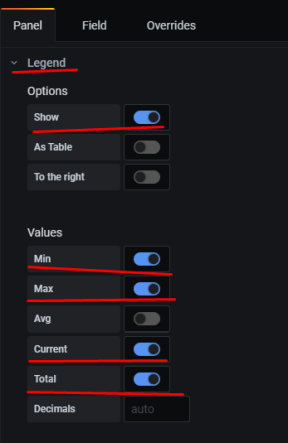
сохраняем:

теперь добавим panel по использованию оперативной памяти в namespace terminal-soft
также создаём новую панель, и используем запрос:
sum(rate(container_memory_usage_bytes{namespace=»terminal-soft»}[5m]))
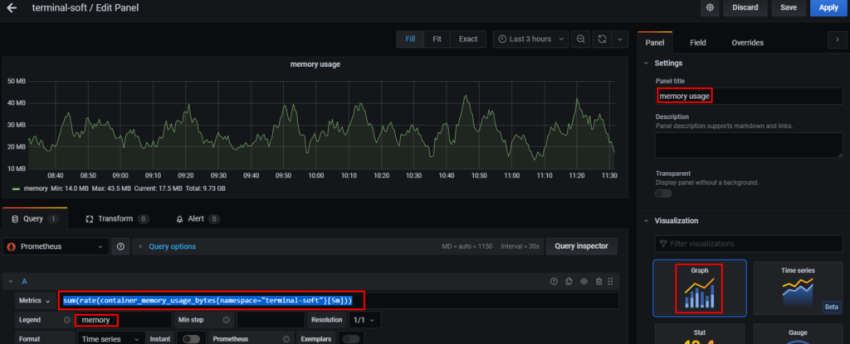
в левой колонке ставим параметр, в чём измеряем (в нашем случае в байтах)
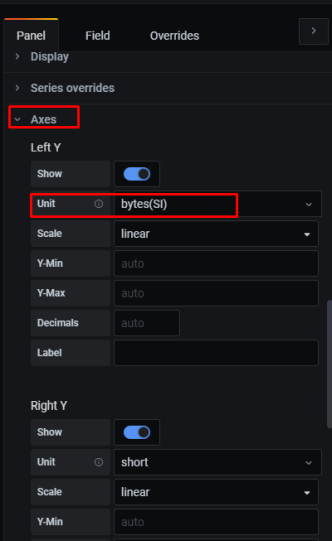
и настраиваем отображаему легенду а именно минимальные максимальные значение и т.д.
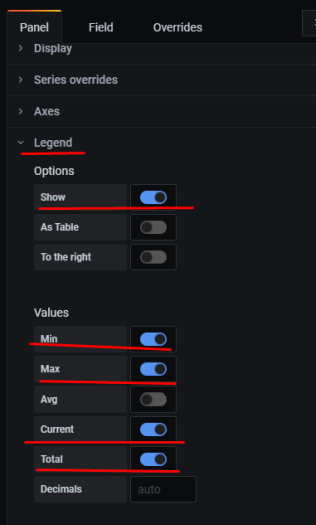
всё можно сохраняться

как видим 2 графика у нас уже отображаются нормально:

теперь отобразим занятое дисковое пространство persistantvolume
создаём новую панель
запрос будет выглядеть следующим образом:
(kubelet_volume_stats_capacity_bytes{persistentvolumeclaim=»$volume»} — kubelet_volume_stats_available_bytes{persistentvolumeclaim=»$volume»}) / kubelet_volume_stats_capacity_bytes{persistentvolumeclaim=»$volume»} * 100
у нас повилась переменная volume рассмотрим как её создать:
переходим в настройки dasboard
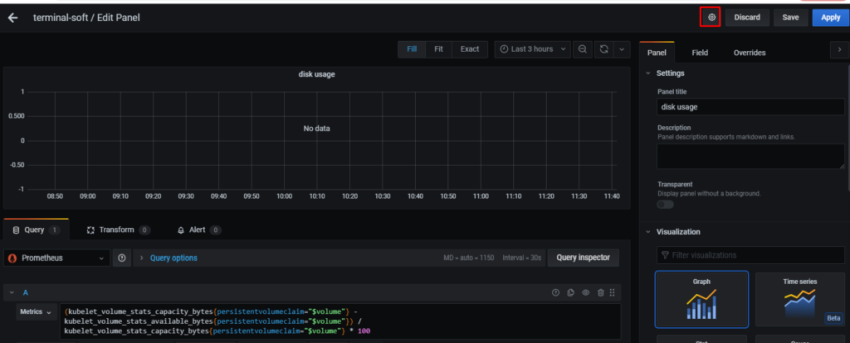
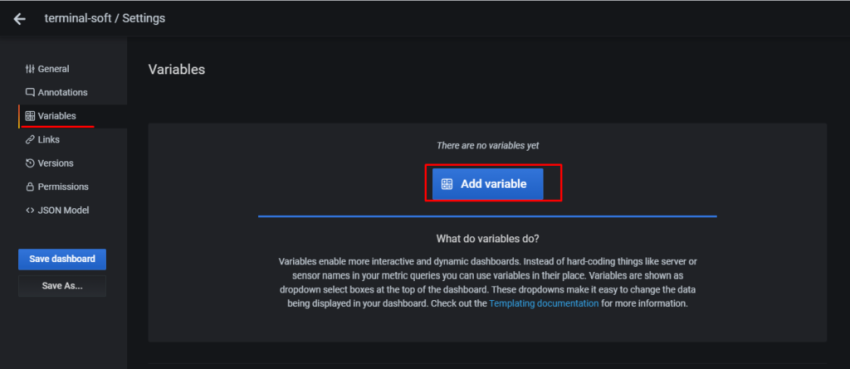
добавим несколько переменных,
первая cluster запрос:
label_values(kubelet_volume_stats_capacity_bytes, cluster)
не забываем ставить Hide Variables чтобы в панели он не отображался
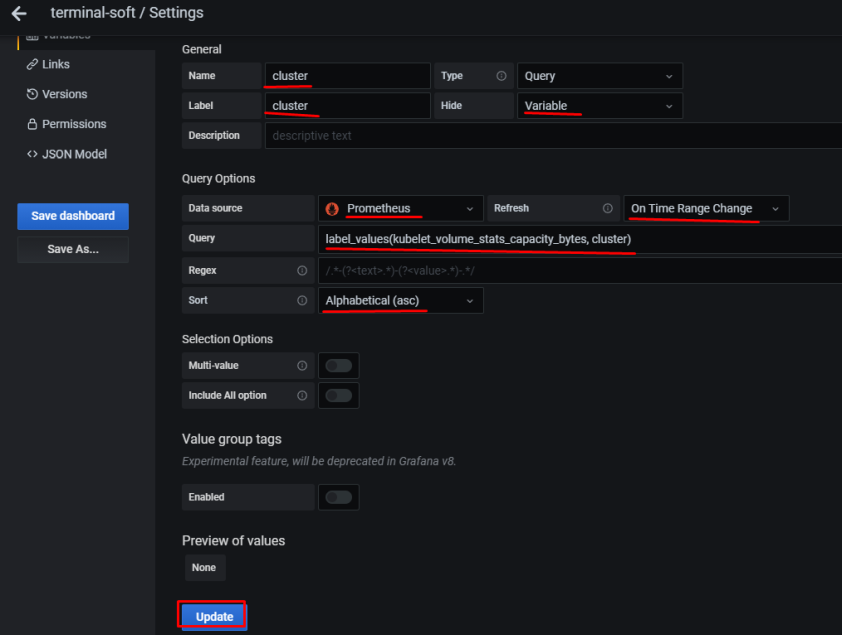
вторая namespace, запрос:
label_values(kubelet_volume_stats_capacity_bytes{cluster=»$cluster», job=»kubelet», metrics_path=»/metrics»}, namespace)
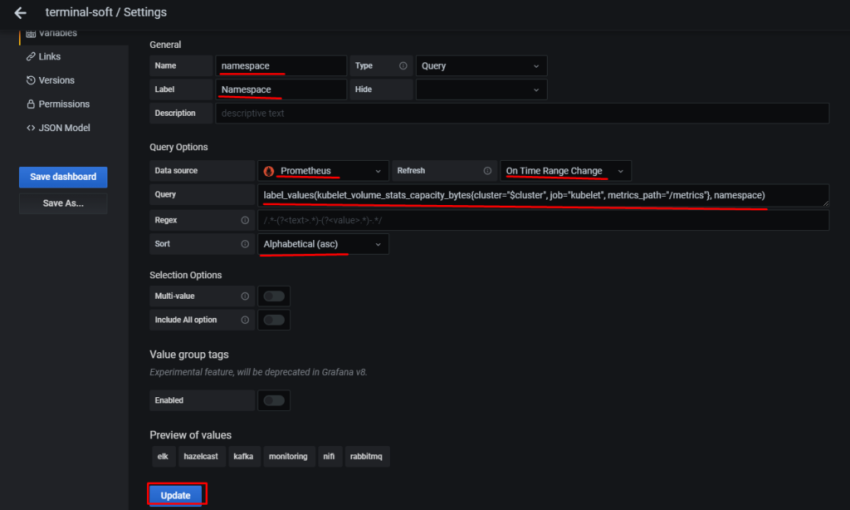
и третья volume запрос:
label_values(kubelet_volume_stats_capacity_bytes{cluster=»$cluster», job=»kubelet», metrics_path=»/metrics», namespace=»$namespace»}, persistentvolumeclaim)
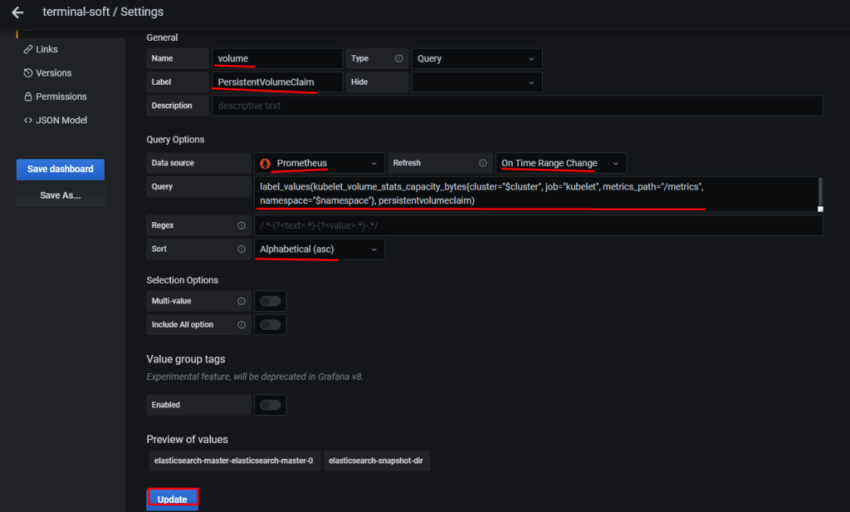
вот наши 3 переменные:

теперь смотрим на нашу панель:
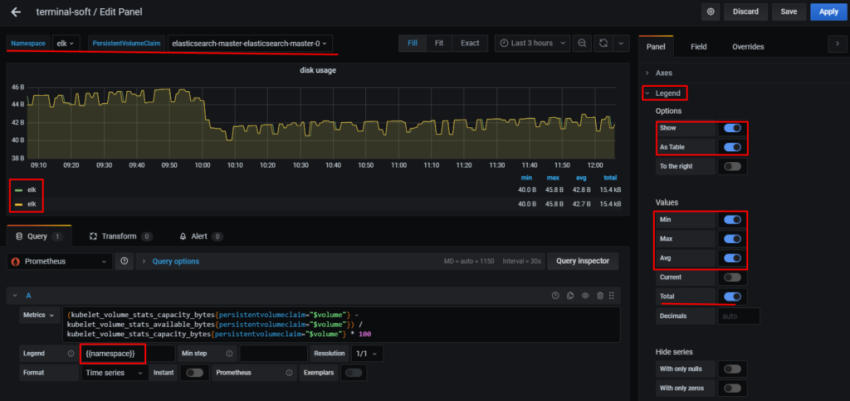
добавляем legend в описании пишем {{namespace}} (чтоб отображался наш неймспейс)
также видим что вверху появились НЕ СКРЫТЫЕ переменные которые мы можем выбирать.
Отображение сети (входящий/исходящий трафик)
используем 2 метрики:
входящий трафик для namespace terminal soft:
sum(rate(container_network_receive_bytes_total{pod=~»deployment.+»,namespace=»terminal-soft»}[1m]))
исходящий трафик для namespace terminal soft:
sum(rate(container_network_transmit_bytes_total{pod=~»deployment.+»,namespace=»terminal-soft»}[1m]))
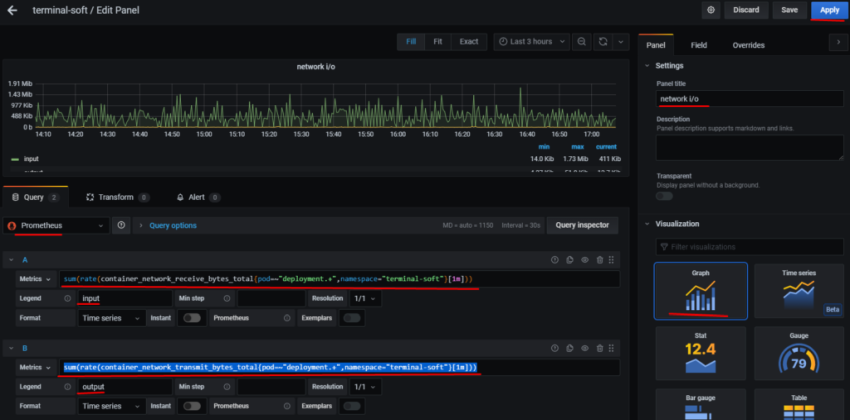
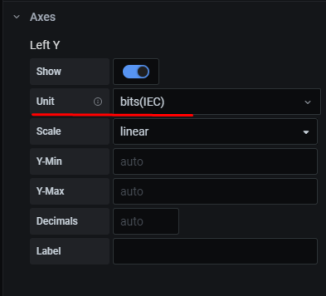
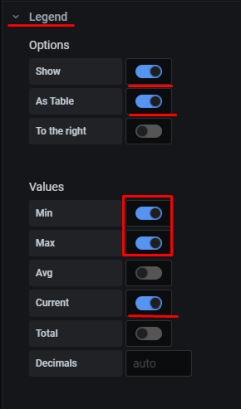
Отображение кодов ответа на nginx ingress controller
создаём ещё одну панель.
дёргаем метрику:
sum(increase(nginx_ingress_controller_request_duration_seconds_count{namespace=»terminal-soft»}[1m])) by (status) > 0
в качестве legend ставим
{{status}} code
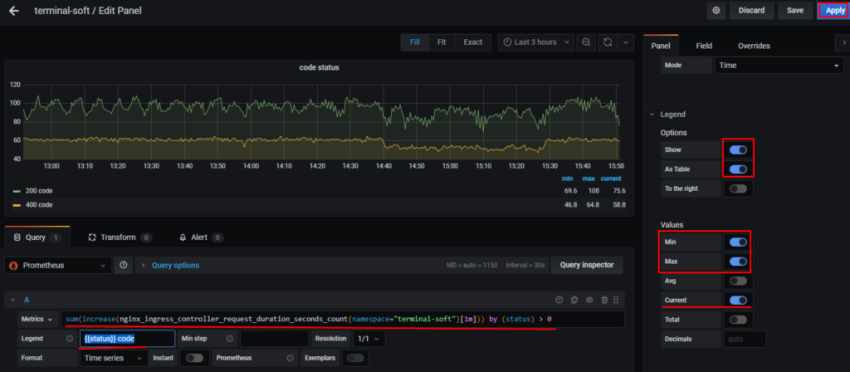
можно сохранять.
ещё добавим несколько графиков для отображения количества ответов по статусам
200(2**)
300(3**)
400(4**)
500(5**)
создаём панель и добавляем запрос:
sum(increase(nginx_ingress_controller_requests{namespace=»terminal-soft»,status=~»2.*»}[1m]))
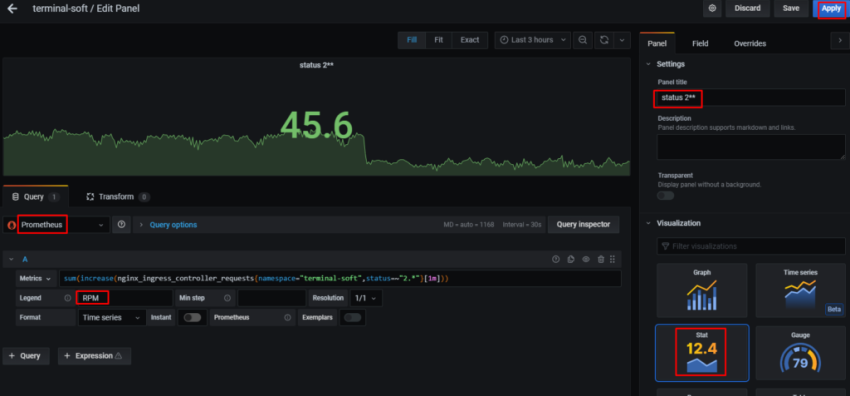
добавляем ещё несколько панелей запросы будут аналогичны первому:
sum(increase(nginx_ingress_controller_requests{namespace=»terminal-soft»,status=~»3.*»}[1m]))
sum(increase(nginx_ingress_controller_requests{namespace=»terminal-soft»,status=~»4.*»}[1m]))
sum(increase(nginx_ingress_controller_requests{namespace=»terminal-soft»,status=~»5.*»}[1m]))
по итогу у нас получился вот такой dasboard
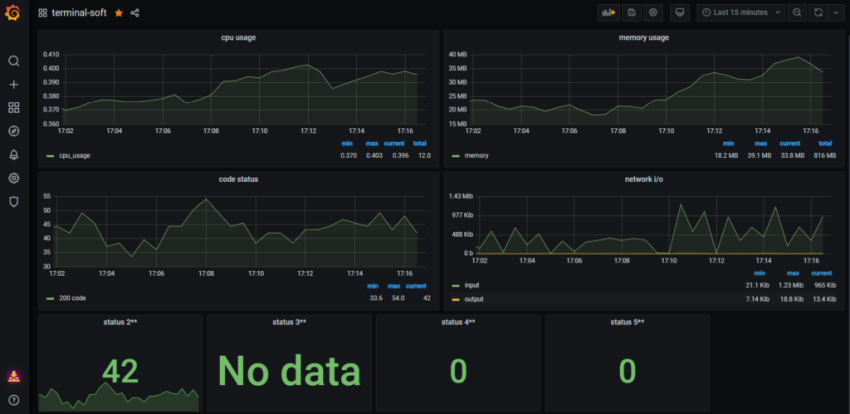
рассмотрим ещё один дашборд где при выборе namespace будут отображаться Проц/оперативка/сеть как на весь неймспейс так и на каждый под в отдельности
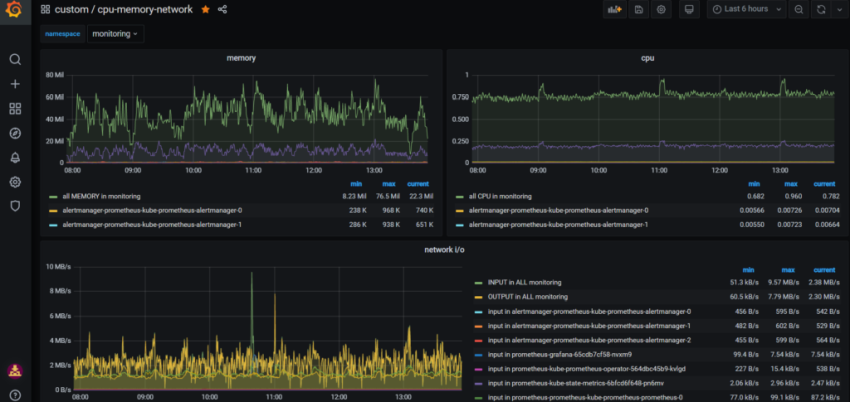
вот так оно будет выглядеть по итогу
переходим в настройки:

далее создаём переменные:
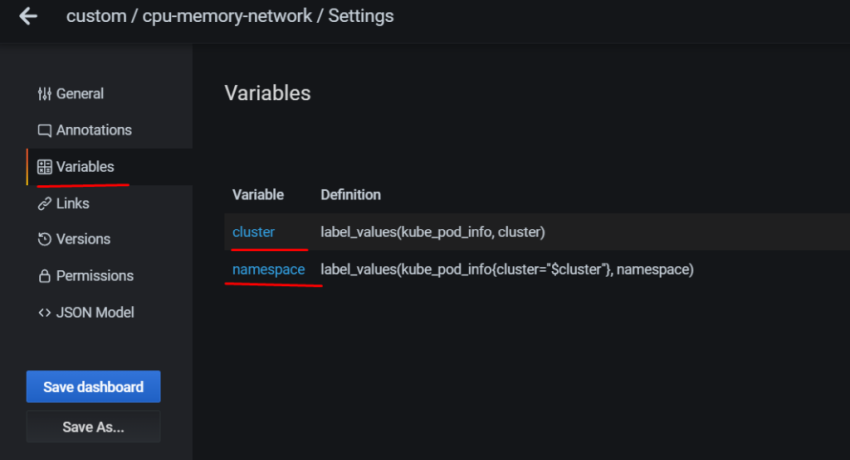
cluster
label_values(kube_pod_info, cluster)
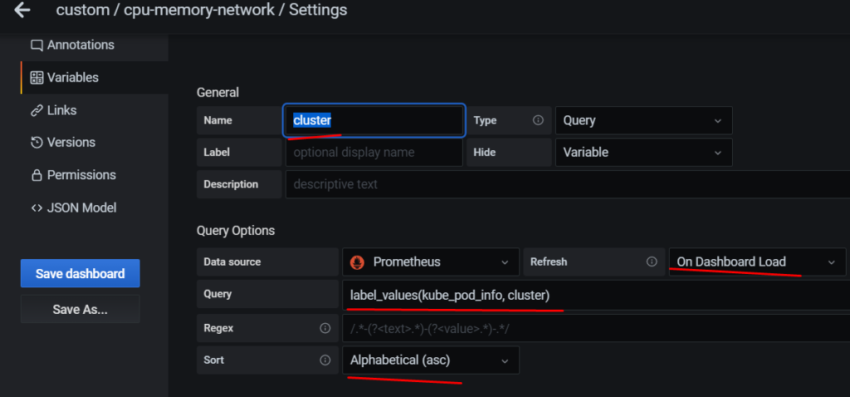
namespace
label_values(kube_pod_info{cluster=»$cluster»}, namespace)
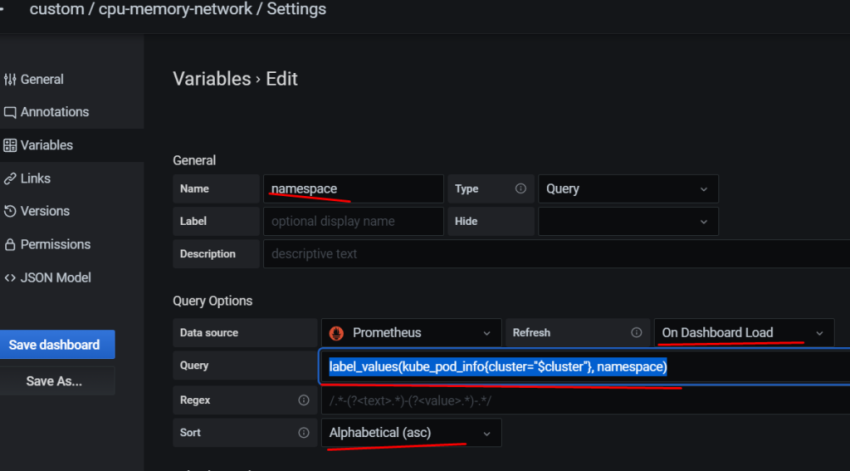
перейдём к настройке самих дашбордов — первый по перативке:
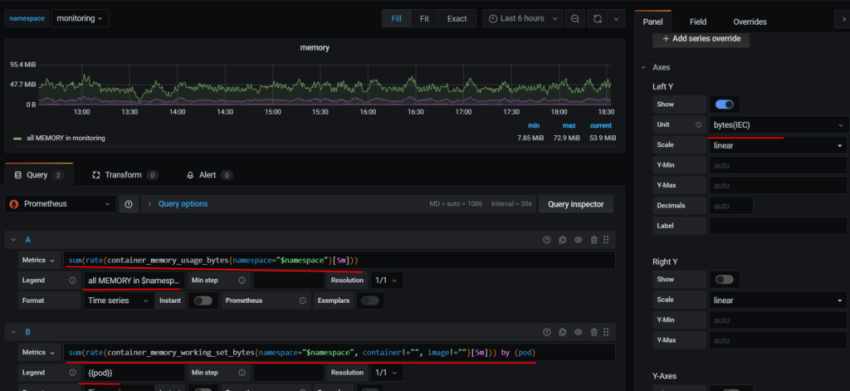
sum(rate(container_memory_usage_bytes{namespace=»$namespace»}[5m]))
all MEMORY in $namespace
sum(rate(container_memory_working_set_bytes{namespace=»$namespace», container!=»», image!=»»}[5m])) by (pod)
{{pod}}
далее проц
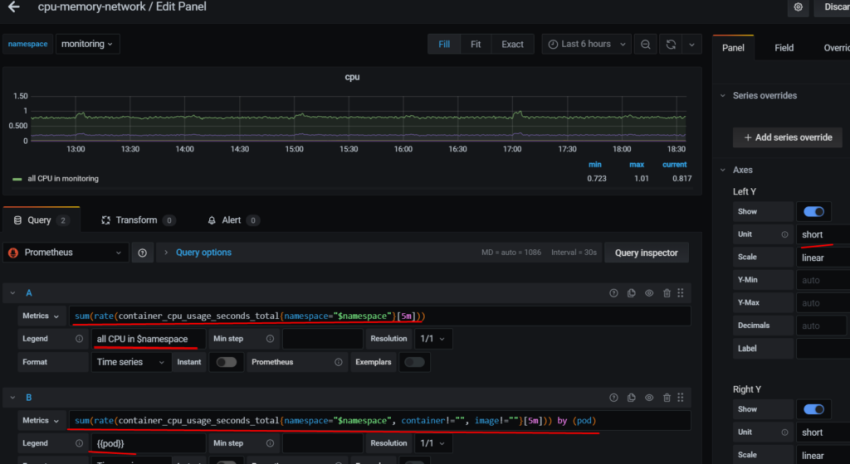
sum(rate(container_cpu_usage_seconds_total{namespace=»$namespace»}[5m]))
all CPU in $namespace
sum(rate(container_cpu_usage_seconds_total{namespace=»$namespace», container!=»», image!=»»}[5m])) by (pod)
{{pod}}
далее рассмотрим сеть:
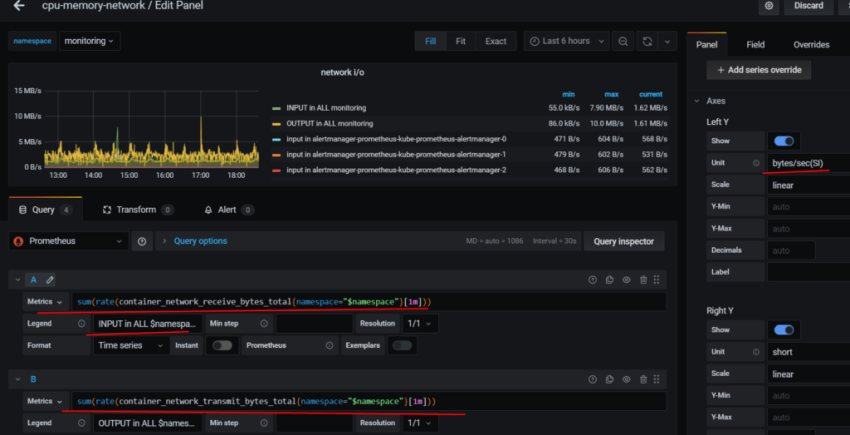

sum(rate(container_network_receive_bytes_total{namespace=»$namespace»}[1m]))
INPUT in ALL $namespace
sum(rate(container_network_transmit_bytes_total{namespace=»$namespace»}[1m]))
OUTPUT in ALL $namespace
sum(rate(container_network_receive_bytes_total{namespace=»$namespace», container!=»», image!=»»}[5m])) by (pod)
input in {{pod}}
sum(rate(container_network_transmit_bytes_total{namespace=»$namespace», container!=»», image!=»»}[5m])) by (pod)
output in {{pod}}
Источник: https://sidmid.ru/kubernetes-запуск-prometheus-grafana-alertmanager-запуск-exporter-для-ingress-nginx-controller/#grafana